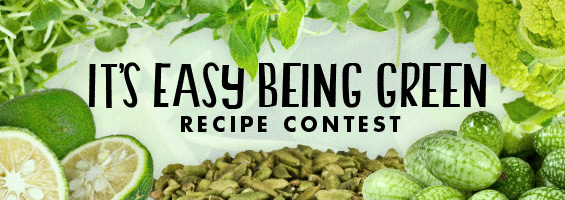
Posts by Helana Brigman:
- 99% of people are trying to do this
- which means…it’s hard to stand out (“they’re impossible to differentiate”)
- You can stand out! Think about style and voice.
- Example: Look at quality bloggers like Heidi Swanson of 101 Cookbooks. She has an identifiable font, unique filters on her pictures, and it’s (quote), “Less about the specific post, but the world you’re sent to.”
- So, “create a world” for your readers.
- If you want to keep it beautiful, that’s great. But, make sure that once they get there, you’ve made something special for them.
- (Other) Example: “The Best Broccoli of Your Life Post”
- Something that’s truly “new” or “unusual” (“novel”)
- Example: What’s Gabby Cooking blog and “Slutty Brownies” post
- This recipe is particularly “novel” because it’s more than a brownie–it’s a brownie with a regular brownie layer, plus an Oreo cookie layer, plus a regular cookie dough layer. (Adam seemed to salivate as he communicated just what made these “brownies” so special to the audience.)
- Take advantage of what’s happening now and what people are searching for, but don’t confuse this tip (or post idea) with a spam-tactic to drive people to your blog.
- Rather, what’s trending socially (say, Manti Te’o’s girlfriend debacle would be appropriate so long as you can figure out a way to turn it into your post or food).
- Example: “Janet Jackson Breast Cupcake”
- A post that takes itself seriously and is interested in answering hypothetical questions with concrete answers.
- Example: pretty much anything from Serious Eats in which Kenji does a test and proves his hypothesis, but the post on “The Ins-n-Outs of an In-N-Out Double, Double, Animal Style” is particularly emblematic of this idea.
- Great way to give you a subject for your blog and posts.
- Example: Julie & Julia Project made this a pop-culture idea
- Useful for when you’re visiting cities and trying to generate new content: “What should I eat when I visit…say…Austin, TX?” (so, another way to play with the “eat your way / cook your way through something” post idea is to focus it on a city or place, not just a book.)
- Buzzfeed made this kind of post very popular
- Example: “21 Best Chocolates to Give Your Valentine” (Adam didn’t mention this one, but I think it’s interesting…mmm…chocolate.)
- Basically, a list of things, bulleted, like this one, that itemizes the “10 signs…” or “10 things…” or ____(insert # + subject)___.
- Easy for readers to sift through.
- Something that’s new, different, and tells a story with a distinct beginning, middle, and end.
- Example: “Chutzpah, Truffles, and Alain Ducasse”
- Why is this an example? In it, Adam admits to being honest about how a $350 meal is just way too expensive, and, as an “amateur” food blogger, he couldn’t afford a fancy restaurant. He was then rewarded with a special dinner for his honesty. Sigh. Karma.**
- **Grey area: see Signe Rousseau’s remarks on Josh Ozersky and Adam Roberts, pg. 53 of her book, Food and Social Media: You are What You Tweet)
- This post is particularly creative and narrative in nature because it uses a Comic Book-style layout to guide and engage the reader.
- When appropriate, it’s “ok” to write a rant-style post, but have some ethical guidelines: Adam suggests “ranting” about things “everyone can relate to” like communal-style tables at restaurants (yuck?! or yay?!)
- Blogs shouldn’t be spaces of negativity, but a source of entertainment and escape for your readers. Thus, keep the ranting low, but feel free to pull out this pocketed ace when appropriate.
- Example: “Only A Jerk Would Eat at Le Cirq“
- Adam emphasized that, “Ultimately, the truth matters.”
- Recap of episodes for a popular TV show is a great way to drive audiences who are already interested in the show to your website. Your shared interest gives them access to your community while keeping your blog informative and fun.
- Example: Eddie Wong at Eater.com’s review of episodes (food-specific) is an interesting example of this post idea (see his review of Taste)
- According to Adam, this is the *most important* one.
- Why? Well, it forces you to connect with your community in a way that’s authentic and autobiographical.
- I perhaps got the most out of this particular post idea, because it made me take a hard look at what I share and what I don’t share at CD. Adam said he was “trembling” or nervous when he hit, “publish” on the post example I’ve listed below, because he had never been so honest with his community of readers.
- But, the best part? His “Emotional, Bare Your Soul Post” is very possibly the “best thing” he’s ever written.
- Example: “It Gets Better (Cooking for My Boyfriend and Our Families)”
- (Other) Example: I found this post by a female blogger named Kate, “The One That’s Hard to Write,” a particularly compelling illustration of this idea. She discusses her hardships in trying to conceive with her husband in the past year. I can always remember the title of the post (it’s catchy, honest, and biographical), but the content she discusses was eye-opening to me as a reader of her blog, and probably the main reason I feel I can comment or return to her website, The Small Things Blog.
Part 5: “What Crazy Thing Can I Do?” Kenji Lopez-Alt of Serious Eats
March 17th, 2013loading...
The final installment of my 5-part review of Kenji Lopez-Alt’s Talk, “I’ve Got a Test for That”: Notes from the Keynote at Food Blog South (2013) ends here (see parts 1, 2, 3, & 4 if you need to catch up).
Personally, I think I’ll always have some concerns about the ways bloggers write for the Internet (especially those that are not just food bloggers, but female “lifestyle” bloggers as well: for me, these authors often raise a series of ethical issues about women’s work and the “do-ability” of our writings’ claims).
But, the flip-side of this kind of judgment is that I’ve never truly entertained how expensive and time-consuming a scientist’s experiments might be when their end-of-the-day goal is simply to write an article about food. Creating tests or charts like Kenji does below is more than a Saturday afternoon extracurricular. It’s that unique blend of “geekery,” recipes, and food writing I mentioned at the beginning of this article.
As you read Kenji’s “What Crazy Thing Can I Do?” approach to food blogging, please keep in mind that it raises some questions about the early, rudimentary ideas of what a food blog actually is. By advocating for the sometimes demanding mathematical and scientific attentions one can only do with certain resources (that is—the aid of a parent-company’s website. A company that will pay him to order everything off of the In-N-Out Burger menu, or fry covertly-attained frozen potato sticks until just the right level of “final golden-brown crispy conclusion”).
In fact, Kenji’s work participates in a new world of blogging where the most successful food and eating websites have advertisers and revenue with which to pay their writers. These are not the same at-home bloggers I mentioned in section 3 that don’t have the time to spell or fact-check before they hit “publish.”
For many critics, one of the major concerns around the changing blogosphere (see Matchar, Hilgenberg, Jacob, and Rousseau) is the issue of authenticity. Part of what makes a blog so appealing to readers centers on the idea that unlike high-power glossies like Gourmet or Bon Appétit, personally-written posts for the Internet are actually meant to be real.
Perhaps it’s our own self-published voyeurism that compels so many readers to click through our posts. And, in Kenji’s approach, I like to believe the idea of that “guy we knew in Bio Lab who was super awesome” may be a very intentional brand that generates his own niche and authenticity as an author.
And I can’t help but question this ongoing transfer of food blogging from personal web-pages (“web logs” or “blogs”) to corporate ones and wonder: are websites like Serious Eats “Food Blogs” in the traditional sense? Or, are they just the next generation of online journalism where Gourmet, the New York Times, and Bon Appétit have finally stopped “swimming against the tide” and chosen to move their publications online?
But, back to Kenji: at the beginning of his talk, he told us up front that a few of these approaches to food were, in some ways, “extreme,” but it’s part of this extremity that makes them valuable examples of how to create original, authoritative content.
[Likewise, they’re also valuable examples of how to create somewhat traditionally impossible content for the old model of an everyday blogger.]
But, these grey areas don’t make Kenji’s advice any less valuable. His maxims of originality and authority still stand because they suggest pretty ideal models for how to question such elements in our own writings.
While many women’s lifestyle blogs may offer “escapist fantasies” that I’ve certainly fallen prey to when reading, Kenji shows how traditionally scientific, “men’s work” can equally be romanticized in the form of a french fry.
Whether the blogger next door has the time to perform his experiments is another issue, but, for now, let’s simply answer his question, “What Crazy Thing Can I do?”
—
– Why So Crazy? –
The last part of Kenji’s talk is particularly fun, because it shows how his own science-minded background informs Serious Eats blog posts (plus, there are more drawings and graphs).
But before I list any of Kenji’s crazy experiments, dyed eggs, or discriminately-studied McDonald’s fries, a little perspective on his approach (triangle tests don’t just happen on food blogs):
Part of Kenji’s experiences as the Chief Creative Officer and food writer at Serious Eats can be traced to his degree from MIT. When we were first getting to know each other, Kenji was quick to point out his family of scientists, and, how, up until a certain point, he’d always thought he’d be a scientist too. It wasn’t until his own confluence of experiences in Boston-area restaurants and the Good Eater blog that food…sort of…just found him.
This must be why I enjoyed meeting Kenji for so many reasons—one, we’re both academics (not the kind of people you imagine as the “average” blogger), and, two, we come from somewhat similar stomping grounds in New England (Kenji’s from Boston, Massachusetts, and I spent a portion of my life on the southern coasts of Rockland, Maine).
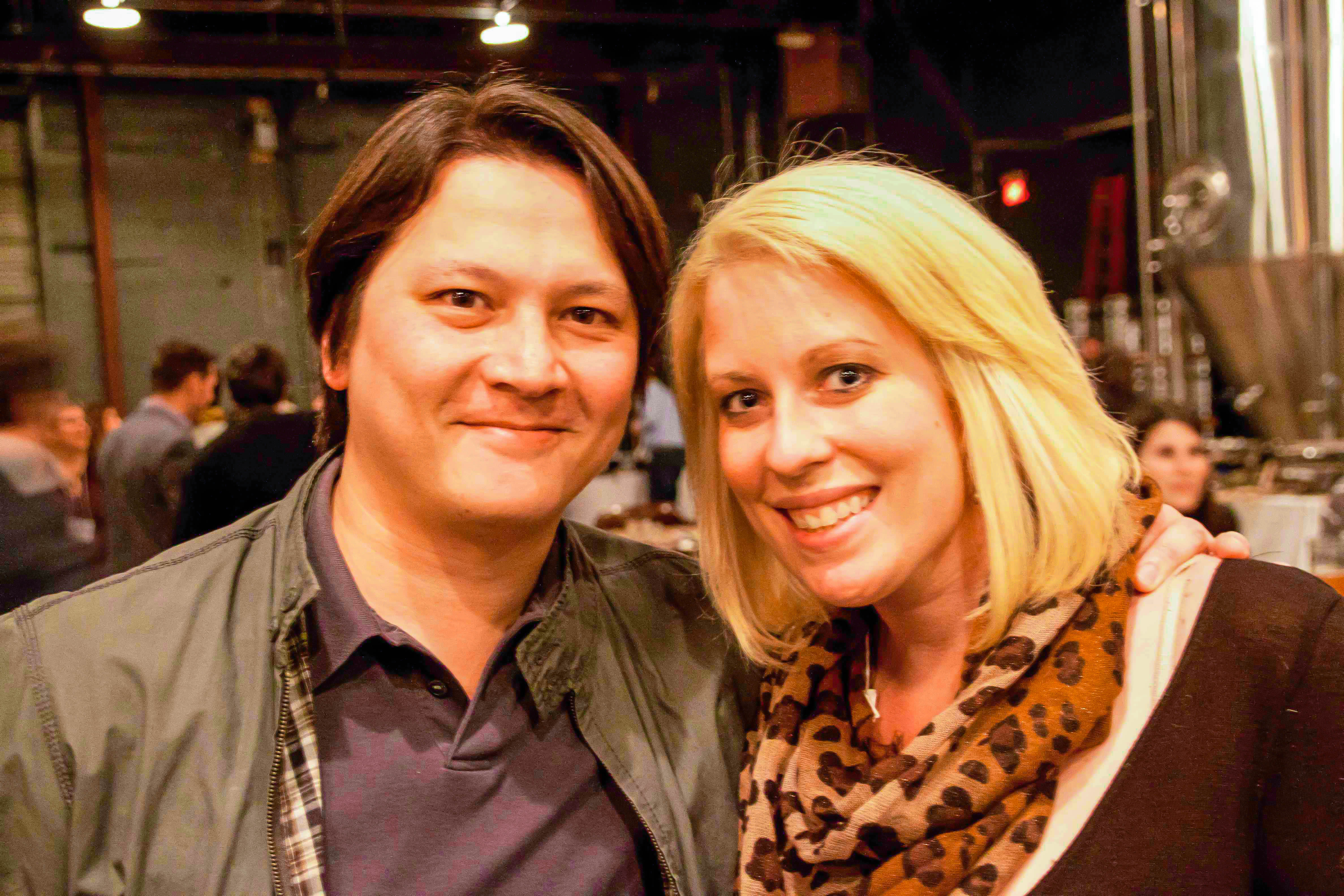
Pictured: Kenji Lopez-Alt and me at the Good People Brewing Company after his Food Blog South keynote speech (January, 2013).
I found Kenji’s story particularly interesting as it somewhat reminds me of my own, since, I know what it’s like to turn your life from textbooks to tapas.
For many writers, food has this magical way of finding you.
You may be looking around, head to the ground, and really searching for something.
Tired, hungry, you make yourself dinner.
Suddenly, you wonder why you stopped thinking about the search or searching at all.
For me, at least, food and its preparation can quiet a busy mind, and the fact that you get to eat your sandwich and think about it makes the whole process extra rewarding.
Plus, knowing how to think and write about food are pretty priceless skills. So if you can bring your academic training into it, then all the better. I keep reading these blogger “advice” columns in which people suggest the secret to blogging success is constantly qualifying your posts with numbers (“5 Things” if you will), but it’s so much more complicated than that.
One of the perks of having any serious academic degree is that regardless of your field—say, science or literature—the regular, critical review of your work gradually awards you many of the skills that make for great posts on food. The fact that you were smart enough to see the bigger picture and quantify it may just be signs of your training. Simply being required to articulate your ideas regularly and specifically can only help to explain why a scientist might make for an excellent food blogger.
I’ll put it this way: food blogging can be like writing a dissertation. To be truly good at it, the post requires thoughtful analysis and a clearly developed thesis.
[No doubt, it’s this kind of logic that took me an extra week or more to hit “publish” on the umpteenth final version of this article….]
As with any dissertation, dozens before you have made their names studying the same ideas, and by the time you get to the subject, you must push beyond the conversation previously lain out before you. Otherwise, you have no notable or distinguishing markers as a thinker.
You’re just another grad student…
or, in this analogy, you’re just another “blogger.”
I find Kenji’s advice particularly useful at this juncture: to push past what’s “good” as a writer and to distinguish yourself by doing something novel and “best” for your readers.
Here, Kenji has another graph that compares the good of Internet writing to what could possibly make it the best:
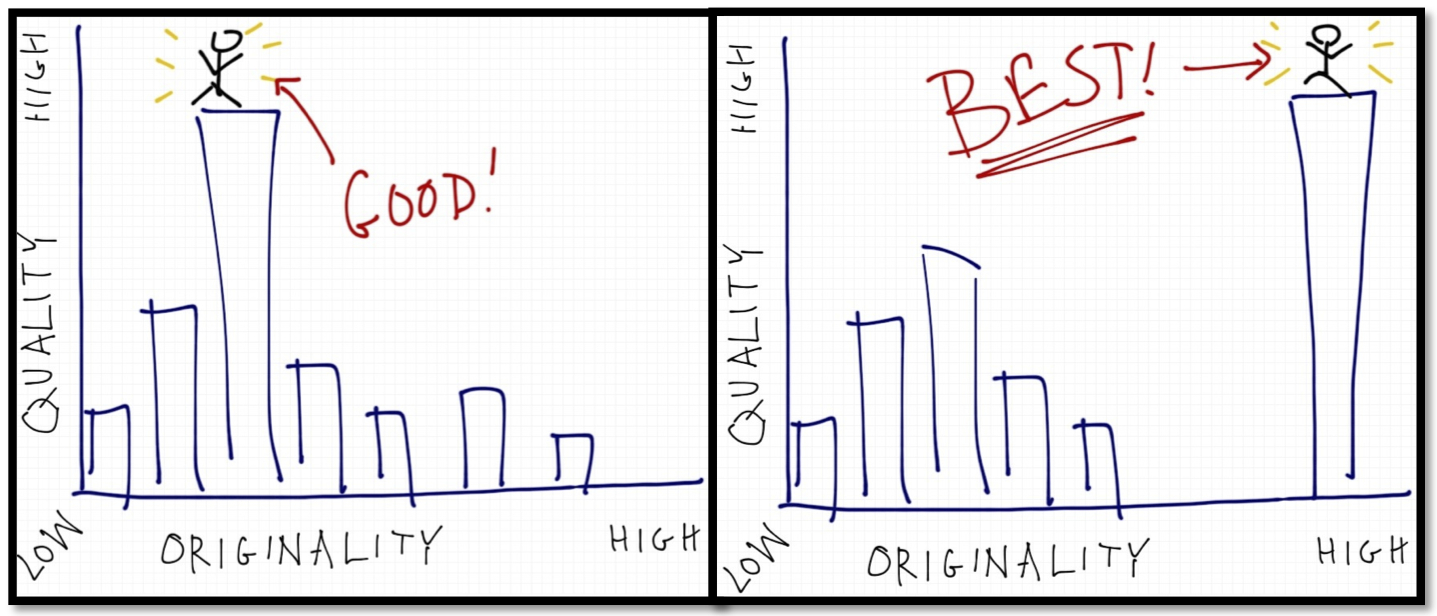
Pictured: two of Kenji’s hand-drawn graphs that show the immediate difference between a blogger who writes “good” content and one who writes the “best” content.
Left: the blogger’s content is “OK” simply because it ascribes to decent levels of originality (x-axis) and higher-than-average levels of quality (y-axis). Right: high levels of originality (x-axis) and high levels of quality (y-axis) mark some of the best bloggers online; however, making these kinds of posts are not, exactly, easy to do.
When I shared this chart with Cristen Conger over at Stuff Mom Never Told You, she responded—
“That quality chart is spot on and simultaneously depressing. It never surprises me when researching even basic topics how low-quality online content often is.”
-Cristen Conger
Although doing something original may be enormously difficult and individual to each blogger, Kenji’s ideas of “going to extremes” and “testing and retesting” offer a great place for anyone to begin thinking about their own approaches and niche.
According to Kenji, what bloggers should really worry about is taking something good, and making it better, or asking yourself—
“What crazy thing can I (or we) do?”
– Kenji Lopez-Alt
And, answer in a way that distinguishes your work’s quality, originality, and expertise.
To help illustrate this idea, I’ve composed some notes from Kenji’s keynote address on many of the great examples of what he’s done, specifically, to bring new authority and perspective to Restaurant Reviews, Product Reviews, and “Best of” Recipes at Serious Eats.
For more of Kenji’s repertoire of posts, see The Food Lab or his 60 recent vegan experiences.
Example 1 – “What Crazy Thing Can I Do?”: Restaurant Reviews
Concept: “We Eat Everything” is an approach that’s significantly more thorough than a regular blogger’s review of a restaurant. Instead of dining at a place once, the blogger tests everything on the menu, distinguishing themselves as an expert in the review.
According to Kenji, “This is the post where we say, ‘who makes the best fried dumplings in Chinatown?'” Because, saying, “here are some good dumplings” just won’t do.
He continues, “We want to be able to say, ‘hey, we’re not just throwing together an arbitrary list – we actually tried every single dumpling in Chinatown ourselves, and ranked them according to very intense criteria – thickness of wrapper, crispness of frying, flavor of the filling, value, etc – and here are the results.'”
Anyone who’s familiar with online food writing can easily see the benefits of this technique: by valuing thoroughness and not being afraid to eat more than one dish, you increase your authority immediately if only because, well, you’re more informed.
Logic: Headlines indicate your writing expertise—
“Every Single Sandwich” holds greater quality and weight than, “I like this sandwich,” or “I tried this sandwich” kind of reviews.
[ Plus, Google likes it when you have authoritative content . . . but I’m not going to bring up Signe Rousseau’s discussion of search engine “Filter Bubbles” just yet. ]
Example 1: “$26 Chicken Sandwich” on “sandwich greatness” at Serious Eats
Example 2: “32 Cheap Eats we Love in Lakeview” at Serious Eats
And here’s where Kenji really sold me with his idea of “evergreen posts.” Or, posts like Alison’s Green Juice Detox that develop lives of their own amongst readers, go “viral,” and stabilize as a regularly active pages on your website.
According to Kenji,
“When it comes to headlines, ‘The Best Dumplings in Chinatown,’ is far more clickable than ‘Joe’s Shanghai Has Good Dumplings.’
And yes, it’s a lot of work to do posts like this, but in the end, it’s worth it.
They become what we call evergreen posts – posts that keep giving long after they’ve been published . . . in this model, you’ve produced an idea that people search for all the time online, but you’re apart of this equation / conversation. Over time and page views, your posts eventually stabilize, allowing for regular, consistent readership that’s driven to the page simply because of what it is. “
–Kenji Lopez-Alt
Example 2 – “What Crazy Thing Can I Do?”: Product Reviews
Concept: Popular food products like “organic” or “locally grown” offer wonderful buzz words capable of influencing eaters’ dining experiences. Whether one believes an organic egg actually tastes better than a pasteurized one is irrelevant. Powers of suggestion and the expectations of the eater can determine more of the dining experience than anything else.
Or, as Kenji noted during his talk about a past test using organic / non-organic eggs, “we discovered that people were more interested in the color of the eggs than how they actually tasted.”
Logic: The scientific method reveals flaws in human palates when placed in a “real world setting: plain, cooked, in dishes.” When study participants tasted foods in blind (and, possibly, “double-blind”) settings, the scientist (here, Kenji) was able to gain an objective understanding of how someone else actually “tasted” (or thought they tasted) the food on their plate.
Example: “Do Better Eggs Really Taste Better?” at Serious Eats

Pictured: a spliced-together 3-panel image of Kenji’s triangle test on organic and non-organice eggs. Left: both eggs unadulterated; Middle: pasteurized egg dyed bright orange; Right: organic egg dyed bright orange.
Can you guess which one the testers valued most?
After a few “umm..this one!” responses from FBS2013 attendees, Kenji revealed that the eggs in the back were always the organic ones, but inconsistently preferred by participants based on these variables in color.
Example 3 – “What Crazy Thing Can I Do?”—“The Best of” Recipes
Concept: Determine your “best ever” recipe for a dish or cuisine, then treat it as the best ever. Simple, right?
Chili—one of Google’s most searched recipes—has dozens of variations in which it “best ever” groupings have been determined at Serious Eats:
(and the list goes on and on; you can read more chili recipes at Serious Eats here).
According to Kenji,
“It’s no accident that I have seven different variations of chile on Serious Eats. You hear a lot about wealth distribution these days. How 1% of the population owns 99% of the wealth. Well it’s the same with recipe searches. Chili IS that 1% that owns 99% of the recipe search traffic.”
–Kenji Lopez-Alt
In some cases, “best of” doesn’t work in terminology, but “perfect” substitutes as well.
When Amateur Gourmet Adam Roberts spoke that morning on the “10 Food Blog Posts That’ll Get You Traffic,” he referenced his “Best Broccoli of Your Life” if only coincidentally: his recipe for roasted broccoli (like the “best of” recipes Kenji compiles above) changed his mind entirely on how broccoli should taste. It, literally, was the “best broccoli of his life.”
Example: PERFECT FRENCH FRIES
Here, Kenji uses a bag of covertly-attained frozen McDonald’s french fries as a way to determine exactly how the recipe would work if you were able to make them at home.
Part of the McDonald’s formula lies in the frozen, pre-made perfection of their product before it ever hits a McDonald’s. According to Kenji, “I find it remarkable that the bigwigs have discovered a way to create a frozen fry that even a one armed eyeless chimp has trouble screwing up.“
And, although frying french fries might be simple, Kenji’s approach to their “crispy brown perfection” is not. Turns out, he has a test for that:
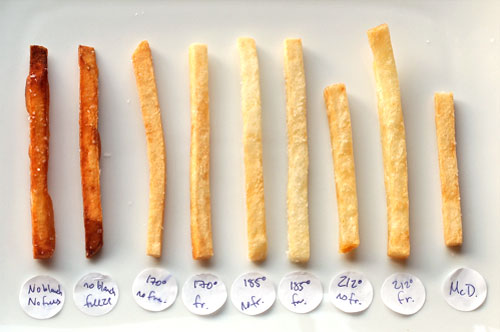
Pictured: Kenji’s results on the road to discovering the “perfect french fry” at home that meet McDonald’s standards of color, flavor, and salt.
When testing his recipe, Kenji prepared 43 batches within 72-hours, defining the “perfect” french fry as
“The exterior must be crisp, not tough . . . the interior must be fluffy and have a strong potato flavor . . . they must be an even light golden blond. . . they must stay crisp and tasty for at least as long as it takes to eat a full serving.”
– Kenji Lopez-Alt
And these standards are hilarious if only because they’re true.
When I was incredibly young, my mother used to pickup McDonald’s Happy Meals on our way home from “Daisies” (the pre-Brownies, pre-Girl Scouts league), and we’d sit in the car, practically dying to eat the french fries. Just waiting until we got home seemed like a challenge, because, even though the drive was short, the fries were not the same when you opened the bag at home.
But knowing “why” McDonald’s french fries deteriorate after a given time, and, at what temperature their results can be made at home is silly, scientific, and just plain impressive.
Kenji detailed the experience as a “mystery novel: quest, colorful characters, dark realities, and final golden-brown crispy conclusion.”
By using his unique blend of geekery and food writing, Kenji applies “high journalistic standards for silly things”
The results? Well, you’ll have to read the full post for everything his research reveals.
—
– Final Thoughts –
If you’ve gotten this far, then you’re probably overwhelmed by the vast amounts of information Kenji shared with FBS2013 (that’s right, this was originally a keynote address, just in case you forgot). And there’s tons of fun facts and ideas that I didn’t (or couldn’t) include here.
Honestly, it’s almost impossible to sum up a keynote speech that covers so much territory at once. In fact, when making final revisions to this post, “Part 5,” it occurred to me that the last section should have been divided into three individual posts (one for advice on product reviews, one for recipes…you get the picture).
But there’s a reason why one post should (or could) be three, and that a keynote review had to be broken into so many entries here at Clearly Delicious, if only, because—
“As a food blogger who wants to have authority, you have to do the work.”
–Kenji Lopez-Alt, Serious Eats
Here concludes Part 5. Thanks, Kenji.
—
Directory:
Or, See: Part 1: “I’ve Got a Test for That”
Part 3: “The Good, the Bag, & the Plain Weird”
Part 4: “The Architecture of a Good Blog Post”
Part 5: “What Crazy thing Can I Do?” (above)
—
Follow me on Pinterest: http://pinterest.com/helana/
Twitter: https://twitter.com/DancesWLobsters
Facebook: https://www.facebook.com/pages/Clearly-Delicious/103136413059101
Tumblr: http://clearlydelicious.tumblr.com/
Instagram: http://instagram.com/helanabrigman
Part 4: “The Architecture of a Good Blog Post,” Kenji Lopez-Alt of Serious Eats
March 7th, 2013loading...
Part 4 of my review of Kenji Lopez-Alt’s Talk, “I’ve Got a Test for That”: Notes from the Keynote at Food Blog South (2013) follows here. Since money often steers part of the issue in generating quality content that’s both written and published for the Internet (AND FREE), deciphering the hallmarks of good online writing may be boiled down to three mantras of quality, accessibility, and community. But, it’s just not that easy (read on). —Helana
– Architecture of a Good Blog Post –
As Kenji explains, finances will, at some point, inevitably affect the quality of one’s blog: whether you have the advertising budget of the New York Times or the low-budget, high-community resources of a website like Yelp.
If finances affect quality, then this model also holds true for levels of community:
Got little money?
Then you’re probably going to have a couple of posts that have at least a few grammatical errors or broken links. You may even leave an ingredient or two off of a recipe’s ingredients list. But, this doesn’t mean that your content is entirely bad – you may have a world of engaged readers pointing out you forgot something or asking questions and engaging you in conversation.
Got lots of money?
Well, alternatively, your recipe may be AP-worthy, tested, and perfect, but you’re most likely never going to e-mail back and forth with all of your readers. You may not even find the time or worthiness of commenting on a page at your high-profile article’s website.
In this continuum of Money vs. Community vs. Quality Content, we meet a new variable: Authority.
Kenji boils down the algebra for this publishing process ( “a + b = c” ) with the four-quadrants below:
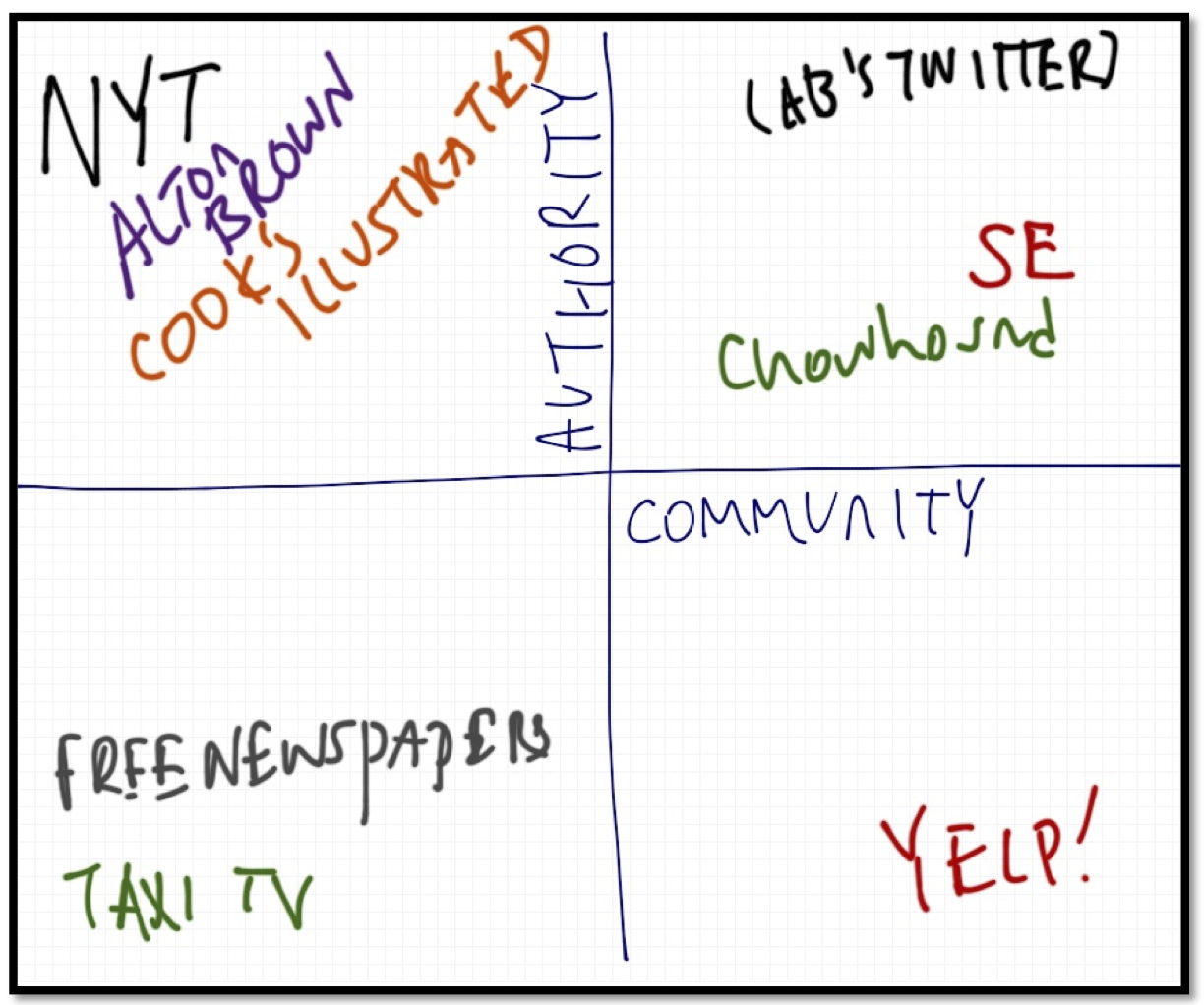
Pictured: X-Axis = Community, Y-Axis = Authority. Kenji’s advice is that bloggers should aim to be in the the upper right-hand corner, where they possess “high authority” as well as “high levels of community involvement.”
If you find the above image a little difficult to discern – what’s “SE?” or “Taxi TV?” for example – then reference the below graph made a little more accessible to us non-science types by my intern Meredith Quinn:
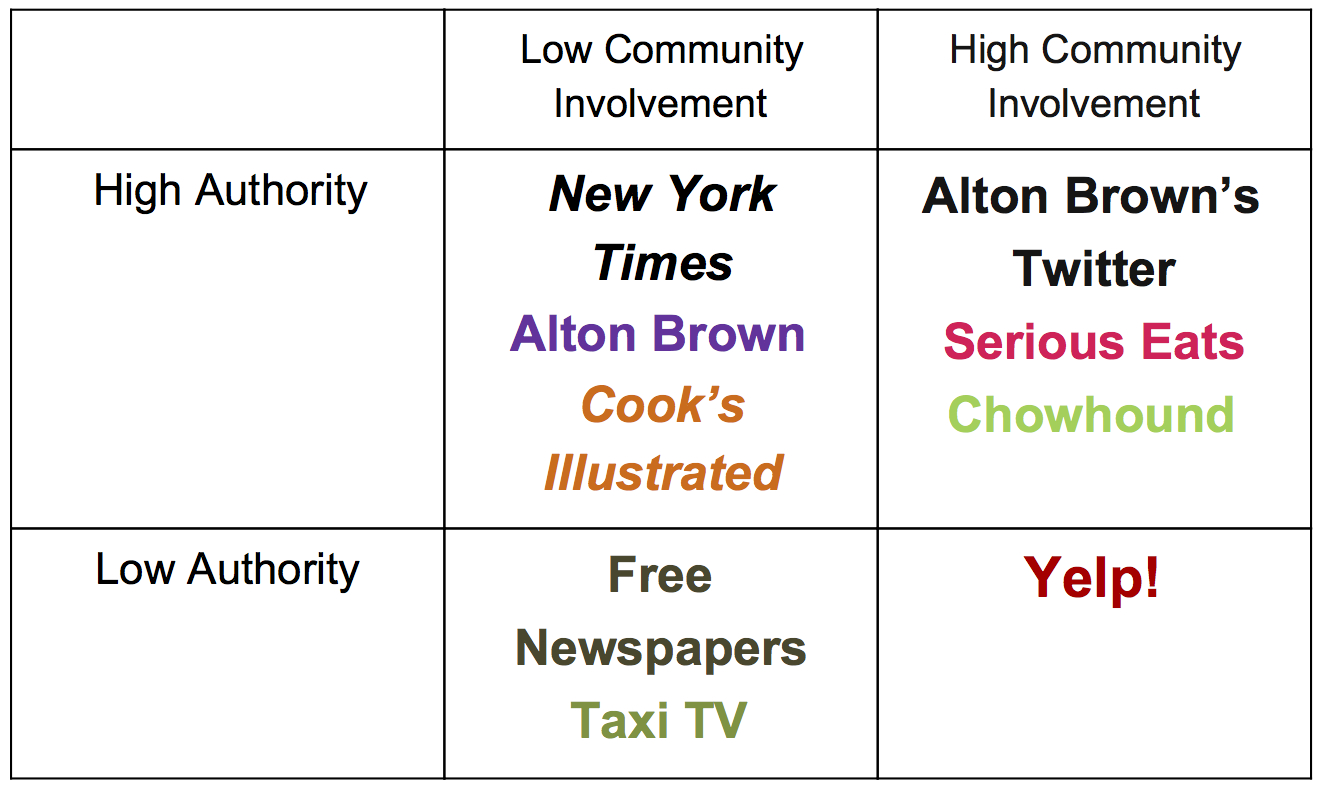
Pictured: Meredith Quinn’s interpretation of Kenji’s graph. In our four quadrants, authority is stacked from highest to lowest where the top two boxes represent “high authority” and the bottom two represent “low authority”; levels of community increase from left to right and each hemisphere introduces possible variances.
Both graphs suggest ways to quantify and digest competing food writers’ experiences based on the success of their community involvement and levels of authority. Plus, they both offer two stable axes on which we can best define “success” (i.e., where “community” and “authority” meet). Do we value the high-community levels of a site like Yelp? The low-authority, guaranteed saturation of Taxi TV? Or, the high-authority measures of Alton Brown-like research with New York Times-like exclusivity?
These kinds of questions illustrate how each quadrant can be distinguished from the other, but, really, they help us to make use of what Kenji wants all Food Blog South attendees to consider:
How can we, as writers, take this information and incorporate it into our own writing? And, what is the “Anatomy of a Good Blog Post?”
Here are Kenji’s three variables:
(1) Well-Written
– Structure: stories with beginnings, middles, and ends
– Balance: content marries seriousness and light-heartedness
(2) Personal
– Passion: peak into your life to see, what makes you, “as a passonate person . . . tick”
– Authority & Trustworthiness:
Clarify what you’re sure about, and what you just don’t know.
Be honest about how much you do know and don’t pretend to know everything. (This honesty will legitimize and earn respect amongst readers.)
Essentially, Honesty = Authority & Trustworthiness
According to Kenji,
“That [structure, balance, passion, authority, & trustworthiness] really describes the best blogs.”
– Kenji Lopez-Alt
(3) Management (“Treat Blog Like a Restaurant”)
– Consistent and Regular: open on schedule; more is better, but have a set of expectations for your readers and stick to it
– Service: people come for the service and will enjoy community once there
– Community: interact with readers as much as possible—
(1) RESPOND, RESPOND, RESPOND! (Answer every single comment)
(3) Acknowledge them directly.
Example: tweet or start a conversation with readers when visiting a new place—
“What food? Drink? Dessert? Coffee? Anything? Should I try?”
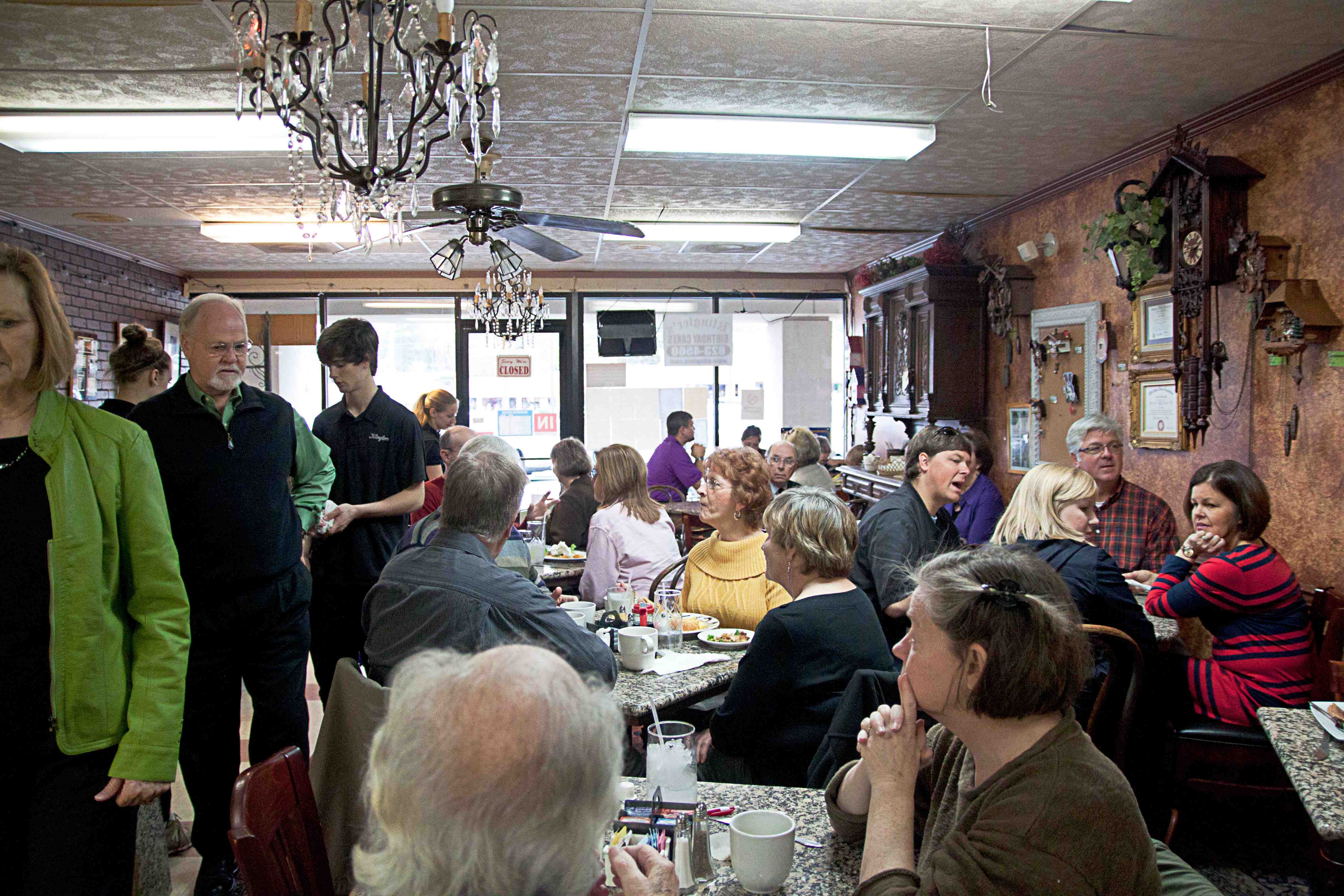
Pictured: Photo taken at Klinger’s European Bakery in Birmingham, AL, the morning after Kenji’s talk. Caroline & I hit up the popular German-style eatery for crêpes, smoked sausage, and insanely rich (but expensive) chocolate cake. I think I subconsciously chose this image if only because of the outsider-looking-in experience we had as travelling food writers seeing how Birmingham locals go about their Sunday mornings for coffee and crêpes. Klinger’s is a small, family-owned restaurant, and its success probably lies in the fact that you can always order your favorite Sunday Brunch Special each weekend without fail.
“This I can’t stress hard enough. I go to some blogs, or even some of the columnists who write for my blog, and readers come in with legitimate questions, and they just sit there, ignored. It baffles my mind. It would be like if a customer walks into a restaurant, asks the server what a word means on the menu, and the server just turns and walks away.”
– Kenji Lopez-Alt
Kenji points out that forgetting to answer a reader’s comments and questions creates a hostile (albeit, perhaps unintentional and somewhat unconscious) environment in which, “You feel snubbed, and you never want to come back.”
Although it may be hard to respond to every single comment a blog entry or online article receives (especially if your writing falls into one of the higher-community and/or higher-authority quadrants above), Kenji’s points are worth mentioning nonetheless:
When you treat your website with the respect, considerateness, and authority of a good, quality restaurant, then your readers (i.e., “customers” in this analogy) have no choice but to enjoy the good service once there.
As for future or potential readers? Just like a good restaurant review on Yelp, word gets around.
For these last points, I keep thinking about what Hunter Lewis said to FBS 2013 attendees the morning of Kenji’s talk. In discussing his experiences as the new Southern Living Executive Editor, he (somewhat disappointedly) pointed out the dramatic shifts that have taken place in the ways readers respond to the magazine over the last twenty years.
During his mother’s Southern Living cookbook days (1960s-70s, I believe), readers were responsible for a huge majority of contributed recipes and letters to the editor. Today, contact between the magazine and subscribers has shifted over time, as food publishers’ continued insulation from their day-to-day readers correlates with higher levels of negative feedback.
[Note: this review trend is not unique to Southern Living, but a part of many readers’ experiences with major food pubs. today.]
Less and less do subscribers write in with positive stories about new recipes or article comments, and more and more, do they write in to complain or criticize recent publications. Hunter lamented these spikes in negative reader feedback over the years (not just for his magazine, but for food publishers and magazines in general).
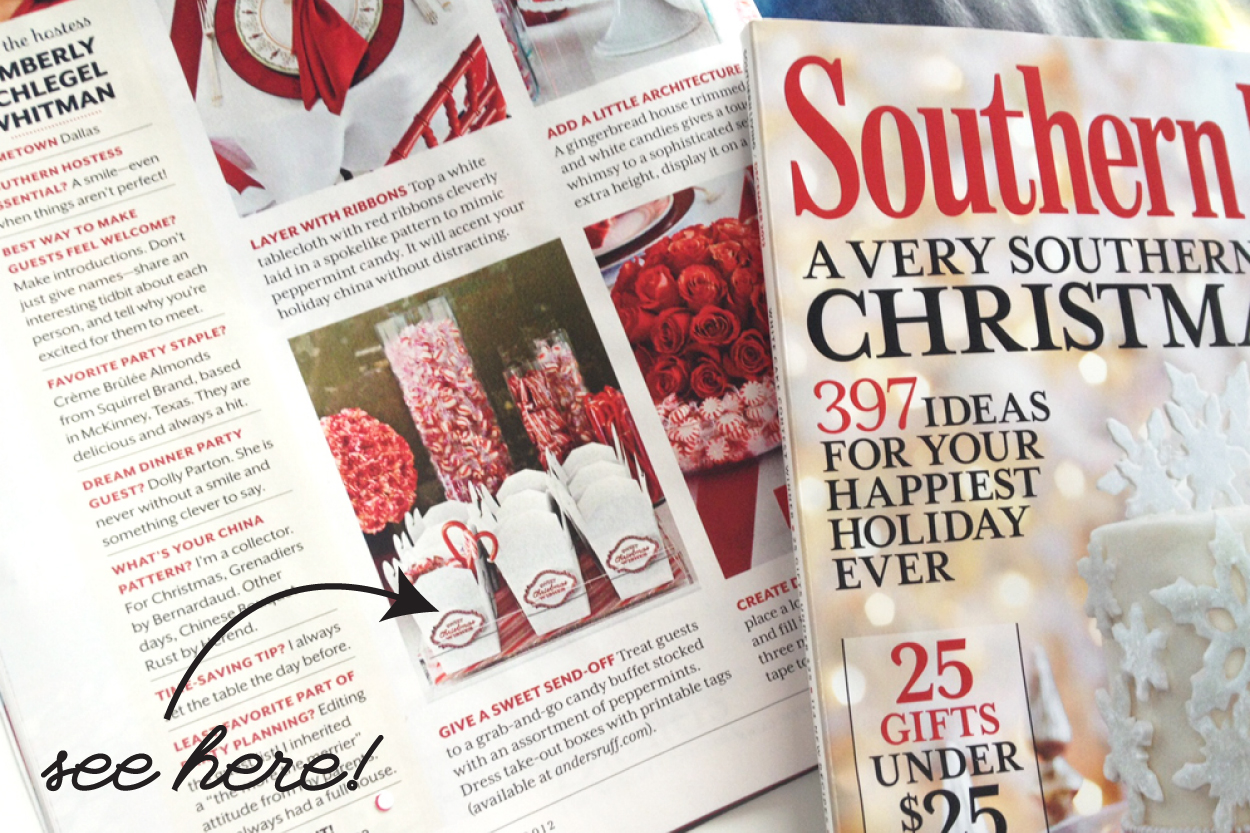
Pictured: pages from a not-so-old copy of a Southern Living Christmas Issue with recipes like the ones Hunter Lewis discussed in his FBS 2013 talk.
By increasing our sense of community with readers—whether it’s a blog, newspaper, or magazine like Southern Living—good things can happen, and an essential ingredient is in place for “good blog post anatomy.”
[More on this last point and Hunter Lewis in my upcoming article on Southern Living.]
My point is this: cultural and publication shifts indicate exactly what Kenji finds so important in reader comments on a blog like Serious Eats: we must engage and connect with our readers; otherwise, we run the risk of coming off as unreachable, disconnected disseminators of information who thoughtlessly share knowledge without considering who or what readers might find when they engage with our content.
Kenji’s “Anatomy of a Good Blog Post” articulates necessary philosophies about food writing: a truly good blog post is like a living thing, and we continue to doctor and understand its effectiveness when we take the time to examine our own levels of community and authority the same way a doctor might with a patient’s capillaries and bones. . . .
[In the words of my intern, Meredith Quinn, “You don’t want to have this conversation with English majors! We can dissect anything, especially imagery!”]
—
For Kenji’s final words of wisdom, Serious Eats examples, and advice, checkout tomorrow’s installment, Part 5: “What Crazy thing Can I Do?” from his talk, “I’ve Got a Test for That”: Notes from the Keynote, to Food Blog South attendees this past January 2013.
Directory:
Or, See Part 1: “I’ve Got a Test for That”
Part 3: “The Good, the Bag, & the Plain Weird”
Part 4: “The Architecture of a Good Blog Post” (above)
Part 5: “What Crazy thing Can I Do?”
—
Follow me on Pinterest: http://pinterest.com/helana/
Twitter: https://twitter.com/DancesWLobsters
Facebook: https://www.facebook.com/pages/Clearly-Delicious/103136413059101
Tumblr: http://clearlydelicious.tumblr.com/
Instagram: http://instagram.com/helanabrigman
Part 3: “The Good, The Bad, & the Plain Weird,” Kenji Lopez-Alt of Serious Eats
March 6th, 2013loading...
Part 3 of my review of Kenji Lopez-Alt’s Talk, “I’ve Got a Test for That”: Notes from the Keynote to attendees of this year’s Food Blog South Conference (2013) continues below. Here, Kenji defines the “Good, Bad, & Plain Weird” of writing and publishing for the Internet, pointing out that, oftentimes, these three features are the same. —Helana
– “The Good, the Bad, and the Plain Weird” –
Part of being a food blogger (or, any blogger, really) means participating in a world where the medium still remains to be properly defined and standardized. There’s a lot of conflicting advice, examples, and user ideas, but, fortunately, it’s fairly easy to locate the sort of “good, bad, and ugly” aspects of what we do.

Pictured: one of Katie Sokoler’s photos of “cats in hats.” Checkout her website for inspiring installation art (as well as these images of “cats in hats”) to see more of her work as a professional “fun maker.”
If the above image is any indication, blogging (at the end of the day) can be inherently strange. Below, Kenji defines the good, bad, and “weird” aspects of blogging as surprisingly similar, if not identical, for a few reasons:
GOOD:
1 – Anyone can do it
2 – Millions of voices; tons of diversity
3 – Niche Writing (there’s literally a niche for everything from the “Ramen Rater” to “Cats in Hats” )
4 – It’s FREE
BAD:
(often, the same as the good)
1 – Anyone can do it
2 – Millions of voices; tons of diversity
3 – Overlap on popular subjects, so “how do you fight the noise?”
4 – Monetizing can be extremely difficult
According to Kenji, these parallels have lead to
“hundred of thousands, if not millions of food blogs on the Internet, and the sad fact is that the vast majority of them are not good, and of the good ones, the vast majority are not financially viable.
It’s simple economics: When people give stuff away for free, they don’t make money from it.”
–Kenji Lopez-Alt
To go back to Kenji’s drawing in Part 1, there’s a reason why “high availability” intersects so surely with “low quality”: not because Internet writers are incapable of doing good work, but because the lack of financial incentive might prevent a writer from consistently spell or fact checking and doing more research when the ability to hit “publish” is right there.
Since the vast majority of bloggers (and this is really just an educated guess on my part) are moonlighting as writers at night—as with the “Mommy Blogger” trend—there’s almost no one holding them accountable for perfecting quality content. In fact, many bloggers turn up their noses to comments that point out their inaccuracy or recipe blips, and this is by no means the same writing supervision one would get from their Food Editor.
[And, might I add from personal experience, that when you do get into blogging, there’s this incredible desire to “catch up” with all of those writers before you. Visit Simply Recipes, decide to start a food blog, then visit Simply Recipes again? Trust me, you’ll want to pump out 10 recipes a week just to keep up with the amount of content found on Elise Bauer’s website! It’s easy to mis-prioritize why our personal domains should have tons of content. We don’t publish regularly (and a lot) just because it makes us look good, but because regular content is one of the few traceable ways we, as writers, can accurately narrate our larger experiences with food. By managing to share this content with our communities in real time, we represent our lives as food writers honestly and create a body of work to return to in the future. See Kenji’s notes on treating your blog “like a restaurant” in the next section (available tomorrow).]
Without pay, the simple truth of any blog will become, at some point, an issue of economics: “free work” runs the risk of = “crappy work” where no one, not even online, can really “get something for free.”
But money isn’t everything.
However, it does provide a great framework for why Christopher Kimball demanded that the skilled few “ask to be paid for what we do.”
As I often tell my students, there’s a reason why some of the best articles online require subscriptions, tantalizing readers with “snippet” views. Good work often requires some financial incentive in traditional models of publication, and being “paid for what we do” not only proves an author’s credibility, but also ensures that readers are paying for something worth paying for.
Not that this perspective is always true, but it’s certainly worth noting. If you haven’t visited Kenji’s “Food Lab” at Serious Eats, then do so immediately. Readers don’t pay for access to articles on tenderizing chicken breasts ( “Why Do I Pound My Breasts?” ) nor do they pay for the “13 Rules of Perfect Prime Rib.” If anything (and I’ll discuss this point further in section 5), Kenji’s call to bloggers to “utilize the Internet’s full potential” offers new ways of imagining old rules.
It also helps us to understand Kenji’s next two points – how to blueprint the “Architecture” of your own “Good Blog Post,” and why community has become so important as we move forward in this field.
—
See tomorrow’s installment, Part 4: “The Architecture of a Good Blog Post” from Kenji’s talk, “I’ve Got a Test for That”: Notes from the Keynote, addressed to this year’s Food Blog South Conference (2013).
Directory:
Or, See Part 1: “I’ve Got a Test for That”
Part 3: “The Good, the Bag, & the Plain Weird” (above)
Part 4: “The Architecture of a Good Blog Post”
Part 5: “What Crazy thing Can I Do?”
—
Follow me on Pinterest: http://pinterest.com/helana/
Twitter: https://twitter.com/DancesWLobsters
Facebook: https://www.facebook.com/pages/Clearly-Delicious/103136413059101
Tumblr: http://clearlydelicious.tumblr.com/
Instagram: http://instagram.com/helanabrigman
Part 2: “Gatekeepers,” Kenji Lopez-Alt of Serious Eats
March 5th, 2013loading...
Part 2 of my review of Kenji Lopez-Alt’s Talk, “I’ve Got a Test for That”: Notes from the Keynote at Food Blog South (2013) follows here. In this section, Kenji examines rules of exclusivity that previously dominated twentieth-century models of food writing and publishing. Comparing our new school of food bloggers to “gatekeepers,” Kenji suggests how changing models of accessibility and authority revise the ways we perceive recipes and food writing. As information becomes increasingly available online, the old “gatekeepers” are both removed from their posts and replaced with what Kenji likes to call, “chain-link fences.”
If you’re interested in the two camps I outlined in yesterday’s section (the “Kimballs” versus the “Levines”) read on, or checkout Adam Gopnik’s New Yorker article “How the Internet Gets to Us” on his theory of “Never-Betters” and “Better-Nevers.” Kenji’s advice definitely falls into the latter, “Better-Nevers,” school of thought. —Helana
—
What the Pros Know:
– “Gatekeepers” –
—
As he discussed his own work at Serious Eats, Kenji outlined more than the use-value of new voices and opinions, but the model we base our ideas on in a world of “Kimballs” versus “Levines.”
In the old model, we trusted the chefs.
The new? “Regular folks writing recipes for other regular folks.”
Here, Kenji defines formally-trained and/or corporate chefs as “gatekeepers” to an exclusive society of writers and food knowledge, determining what is written, eaten, or “trendy” in the world of food. Later, newspaper and magazine editors became the gatekeepers, moving expertise out of the kitchen and into the tasting room of any given, well-funded, glossy food pub.

Pictured: image of a Gothic castle with weighty stone walls and barriers to entry. Kenji uses gatekeeper imagery to compare the world of pre-Internet food writing and publishing where those in traditional positions of power (magazine execs, advertisers, glossy pubs with high circulation) bar all but the select few to their ranks.
Kenji articulates this analogy as follows: “the old gatekeepers have been removed from their posts at the gates, but that is in no way the same thing as saying that the walls have been torn down.”
He continues,
“I like to think of it as the walls have been replaced with chain-link fences. We can still see what’s out there trying to get in, and just because the ‘gatekeepers’ have been ‘removed’ from their posts doesn’t mean there’s a flood.”
–Kenji Lopez-Alt
Rather, Kenji sees a “chain-link fence” in which “we are the gatekeepers. We decide who comes in and out of the gates.”

Pictured: page from an illuminated manuscript in which a castle is under siege, and pillagers fight to gain access. Here, individuals outside the kingdom fight for entrance into positions of authority and power defended by stone-throwing guards. Climbing the walls is difficult, but not impossible.
During his talk, I scrawled down notes outlining Kenji’s points, but I failed to understand exactly how he went from “gates” to “chain-link” fences:
I think the simple shift in architecture is pretty compelling—Gothic stone walls exchanged for modern barbed wire.
Plus, “gates” tie in perfectly with the mythic (but highly vulnerable) status Kimball assigned his colleagues with the closing of Gourmet: as old-school editors and food writers, protectors of an exclusive, coveted kingdom, they’re surrounded by what Kimball dubs the “ship of fools,” regularly afraid of villainous attacks by “pirates” or pillagers at any moment.
For editors or publishers wishing to “swim against the tide,” Kenji’s analogy illustrates how highly enforced barriers determine whose voices can be heard in old, twentieth-century models of publishing. But as I was discussing this part of the keynote address with my Editorial & Writing Interns, Erica (deVeer) noted quite aptly,
“but, chain-link fences don’t hold out water; water flows right through them.”
And then Amy (Laws) chimed in, “Perhaps we just need some wire cutters to tear down the fence?”
And Tara (Hebert) added, “Or, maybe, if we’re the fence, then we’re really just standing our ground as the water flows through and around us….”
After a quick pause, I asked,
“So, what does the flowing water represent in this analogy?
Do you think it’s different bloggers’ voices and their user comments? Maybe it’s the larger community of bloggers writing on the Internet in which we’re standing our ground? And Christopher Kimball (and those like him) are ‘swimming against the tide’ because they’re fighting our conversations, or, at least they were in 2009?
. . .and that’s why water flows through this new gate. . .the barbed wiring?”
This was one of those great communal teaching moments in which we all seemed to pause and go: “ahhhhhh. . . .”
Fortunately, Meredith (Quinn) snapped us back to reality—
“You don’t want to have this conversation with English majors! We can dissect anything, especially imagery!”
Hmph. Point taken.
Let’s move on.
—
“Move on” with tomorrow’s installment, Part 3: “The Good, the Bad, and the Plain Weird” from Kenji’s talk, “I’ve Got a Test for That”: Notes from the Keynote, from this year’s Food Blog South Conference (2013).
Directory:
Or, See Part 1: “I’ve Got a Test for That”
Part 2: “Gatekeepers” (above)
Part 3: “The Good, the Bag, & the Plain Weird”
Part 4: “The Architecture of a Good Blog Post”
Part 5: “What Crazy thing Can I Do?”
—
Follow me on Pinterest: http://pinterest.com/helana/
Twitter: https://twitter.com/DancesWLobsters
Facebook: https://www.facebook.com/pages/Clearly-Delicious/103136413059101
Tumblr: http://clearlydelicious.tumblr.com/
Instagram: http://instagram.com/helanabrigman
Part 1: “I’ve Got a Test for That,” Notes from the Keynote, Kenji Lopez-Alt of Serious Eats
March 4th, 2013loading...
Please join me in welcoming Kenji Lopez-Alt, the Chief Creative Officer at Serious Eats. My review of his keynote speech to the attendees of this year’s Food Blog South Conference follows. Here, Kenji discusses the Serious Eats philosophy, his work at the website, and the hallmarks of good food blogs.
Please note: in about 75-minutes, Kenji fit in more information than any keynote speaker I’ve ever seen, and to help make sense of his 54-pages of notes (thank you for sharing them Kenji!) plus the 10+ pages I recorded during the talk, I’ve chosen to divide this article into 5-part installments (a real first for Clearly Delicious). Check back each day this week for one of Kenji’s key points and/or read on for Kenji’s call to food writers that they take full advantage of the Internet’s potential when crafting their posts.
Also, a very big thank you to my writing / editing interns—Erica deVeer, Tara Hebert, Amy Laws, & Meredith Quinn—for helping make this article as clear, useful, and informative as Kenji’s advice. Kenji’s food blogging philosophy is very important to me, and I couldn’t be more pleased with your notes & helpful revisions to my article. What an incredible way to start the spring program at Clearly Delicious! Now, here’s Kenji Lopez-Alt. —Helana
—
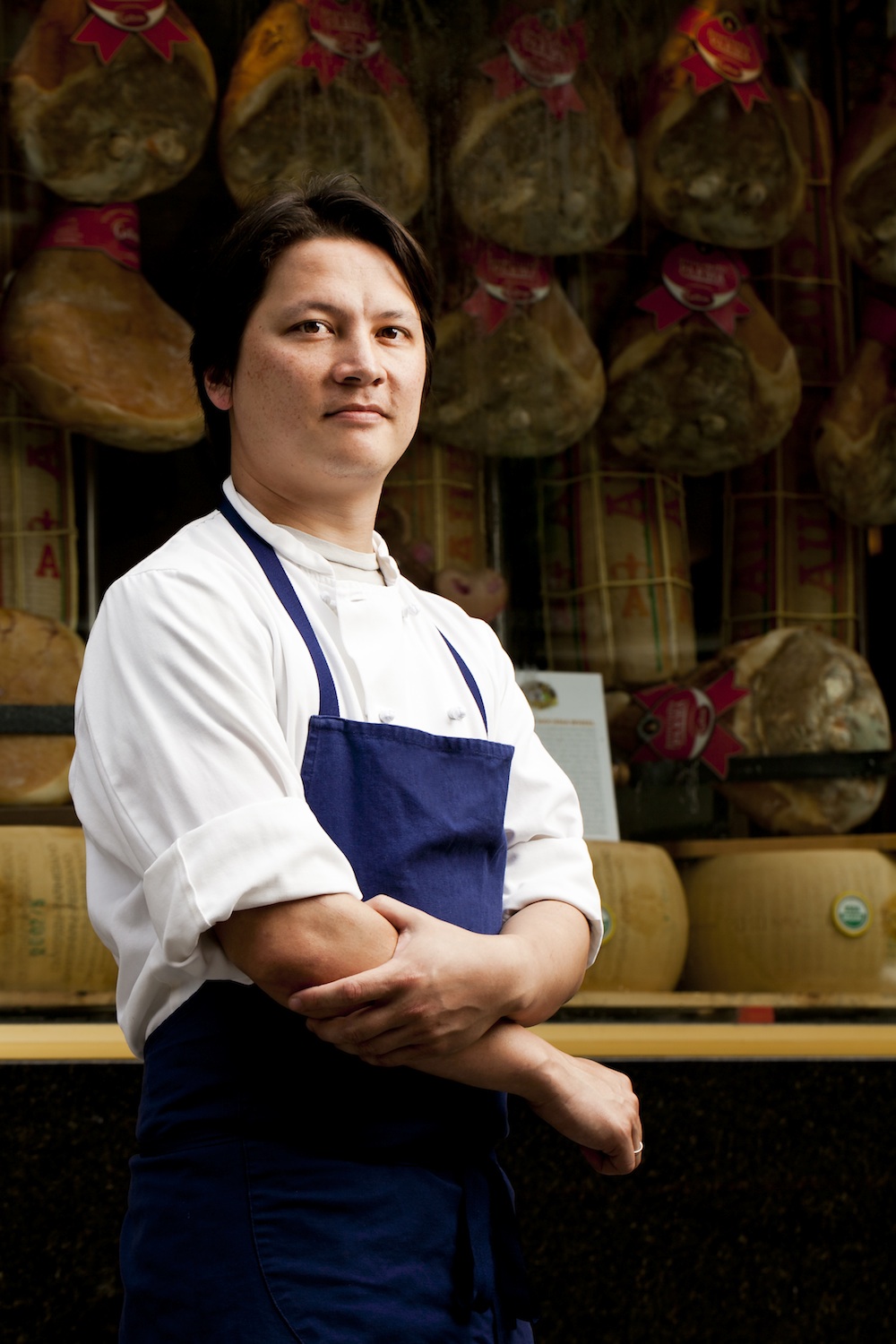
Kenji Lopez-Alt is the Chief Creative Officer at Serious Eats. Famous for his work in “The Burger Lab,” Kenji blends “geekery,” recipes, and food writing in an unmistakable, empirically-based style . Whether he’s using triangle tests or the scientific method, Kenji shows readers how blogging is more than recipes or fancy pictures, but an opportunity to move beyond trendy blogging strictures with a pinch of experimentation. In fact, distinguishing your writing may be as simple as a bunsen burner or erlenmeyer flask.
Photo by Peter Tannenbaum
—
“The internet is new and exciting. There are so many ways to share and discover information, and if you aren’t utilizing it fully, if you are still treating it like an old media source, then you aren’t actualizing your full potential or the potential of your readers.”
– Kenji Lopez-Alt
I believe it’s important to note that Kenji Lopez-Alt opened his talk to the 2013 Food Blog South audience by theorizing food bloggers’ potentials: unlike the old-school print mediums of twentieth-century periodicals (Cook’s Illustrated, Gourmet, and the New York Times), food writers today—especially those online—must push to reconceive what it is that they (or, we) do.
As beautiful as our posts or as expensive as our DSLR lenses may be, food bloggers are not the 90s Ruth Reichls of the world, capable of changing a restaurant’s popularity with a single article or re-defining food trends with their chopsticks.
Rather, we makeup the newest, current generation of writers who, for the first time in the history of cookbooks or food writing, have the potential for revising the ways readers think and talk about food if only because we are members of their online communities. In so many ways, we are very much unlike the food writers before us.
[ Wait—Maybe we are capable of influencing a restaurant’s success, but in our contexts. In the words of Whitman, “Do I contradict myself? Very well, then I contradict myself, I am large, I contain multitudes.”]
And this is where Kenji’s talk becomes especially interesting. Variables such as reader involvement, blog communities, content quality, and a blogger’s authority must always be taken into consideration as we write our posts.
But, I’m probably getting ahead of myself.
Like retired New York Times Food Critic Ruth Reichl, online food writers of all levels of exposure author thousands of conversations each day. They raise ethical issues and stir up controversy, generate debates, and, sometimes, just act badly when it comes to restaurants and the places they eat. As what Kenji calls the “new gatekeepers,” food bloggers have a series of options before them:
How much do food bloggers engage with their online and physical communities?
What are the hallmarks of good content?
And, how do online food writers keep content simultaneously good and professional?
These questions must always be asked (or, at least considered) since rapidly changing technologies continue to adjust how we think or read about food. As a fairly young generation of writers, we’ve already played a huge role in redefining the ways people access the food they’re ultimately eating (or, planning to eat). How your mother, my father, or somebody’s cousin considers the foods they put on their plates (or, might put on their plates, as in, what restaurants to go to or recipes to try) exists in a completely different sphere than word of mouth at your neighborhood haunt.
Let me put it this way: Kenji points out that as new ways to discover and share information become increasingly available, the quality of this content has no choice but to decline:
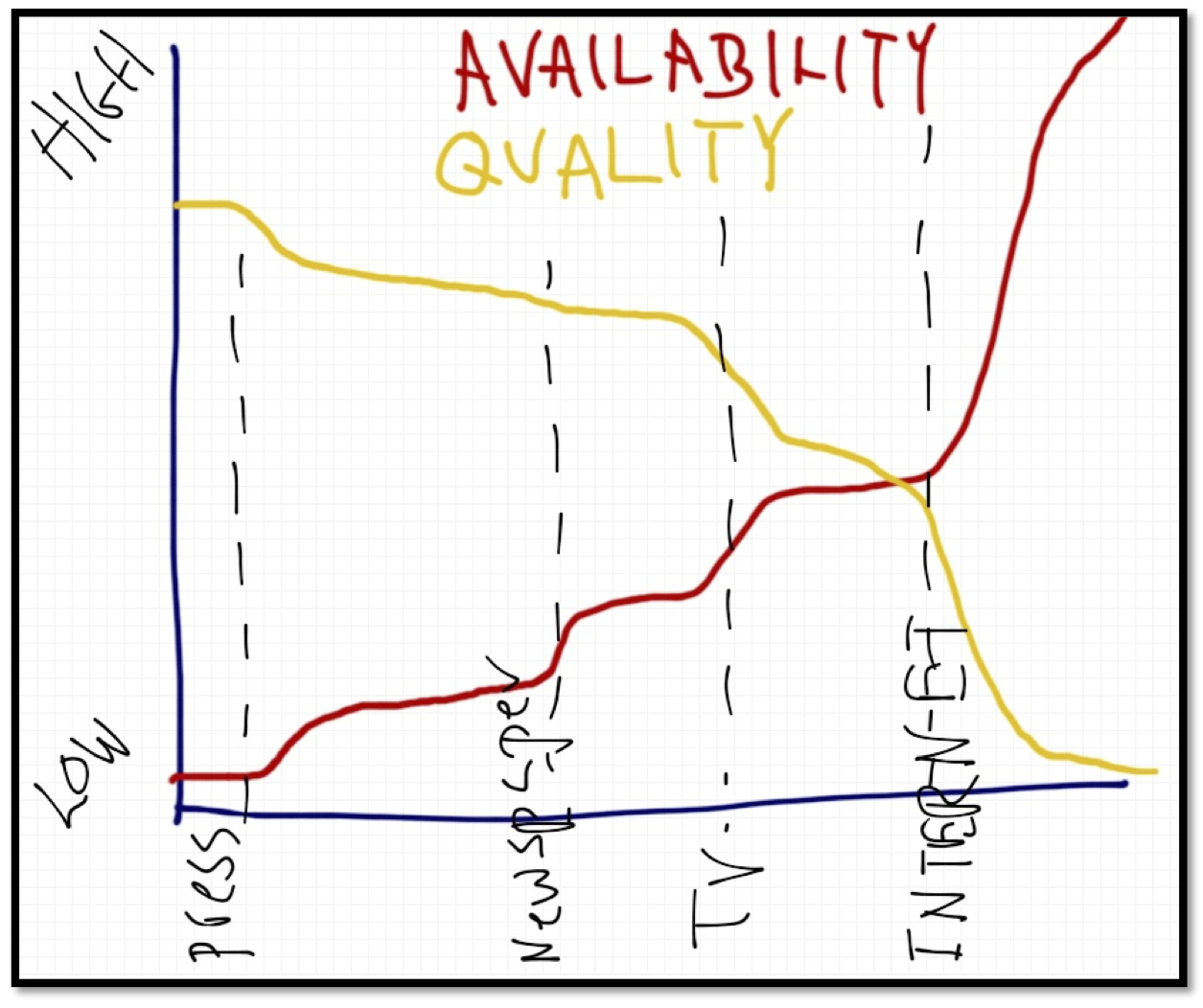
Pictured: one of Kenji’s hand-drawn graphics from his keynote address to FBS2013 attendees.
Y-Axis: low to high; X-axis: various food writers and where they publish.
(Note how the Internet offers high levels of availability but intersects with lower levels of quality.)
This online terrain is troubled, massive, and wildly informed. Who becomes a voice worth listening to? And, what do they have to say?
Especially in a world, where, everyone’s a critic?
—
Use & Abuse:
Understanding Expertise
—
Before I offer Kenji’s advice on the hallmarks of good food writing or engaging our communities, I think I should first point out what it is we should not do:
(1) Misuse social media or its mechanics
(2) Troll or target community members
[Note: Kenji didn’t stress these two points in his talk the way I’ve spotlighted them above, but I list the unpredictable nature of social media here so we can move forward in envision what “good” food writing looks like in an online world that can be potentially anonymous and ugly.]
In this sphere, food writing has never had more potential for including individual voices, and one blogger’s (or reviewer’s) voice is now capable of doing this and, well, hilariously this:
http://youtu.be/INDtZifMsFM
A clip from this season’s Portlandia in which Candace & Toni, co-owners (and life-partners) of Women & Women First Bookstore, discover a negative review on Yelp…and…well…do something about it.
This “high availability, low quality” environment creates opportunities in which we, as writers, run the risk of engaging our communities in negative ways, or falling down waiting rabbit holes a little too easily. Christopher Kimball famously targeted these dangers when dubbing online writers as the Internet’s “million instant pundits,” sailing aboard a “ship of fools” of which he wanted no place in the Carnival-style buffet line.
Citing former boss Christopher Kimball’s same 2009 Op-Ed for the New York Times, Kenji summarized the magazine exec’s anxieties over how the Internet has affected industry publishing— “Will I have a job next year?” —quoting Kimball’s argument that the “world needs fewer opinions and more thoughtful expertise—the kind that comes from real experience, the hard-won blood-on-the-floor kind.” After all, this is an editor who ends his opinion piece not in his own words, but in (“expert”) Julia Child’s famous, “Where did you train, dear?”
Wearing some sort of invisible ninja goggles, Kenji put Kimball’s commentary into perspective for us:
“Now you can imagine . . . the reaction this kind of talk stirred up on the Internet, which, incidentally, was where most people were reading it, NOT in the printed pages of the newspaper.”
– Kenji Lopez-Alt
Kenji’s advice?
Let’s redirect our new-found power for good. Not just the good of our community and industry, but also “good content.”
And, let’s think about what “good” can actually mean as writers who craft and publish articles that respect our readers’ intelligence. In Ed Levine’s response to Kimball’s piece, he (like Kenji) points out the unspoken grey area our famous Cook’s publisher fails to mention:
“The democratic aspect of the internet that’s so terrifying to the old guard is not one that means that every opinion is equal. It just means that every opinion can be equally heard.”
-Ed Levine
I would add to Kenji’s, Levine’s, and Kimball’s remarks that every opinion is open to new definitions of “expertise” as well.
If old-school publishers like Kimball are so concerned with the mantra, “where did you train dear?” then I’d like to respond— “on a lobster boat, every day, for 7 years” —not at the Cordon Bleu, where red-faced, high-blood-pressured chefs yelled at me in their native tongue, thinking I could not understand their language.
Plus, Kimball’s “hard-won blood-on-the-floor kind” of experience is wildly un-literal in its claims—those of us who have actually seen “blood on the floor” because we’ve cooked and trained in traditionally laborious positions only to be shafted as “manual laborers” and not experts disconnects highly from who, really, might be preparing our food.
And, based on this definition, aren’t lobsterman who untie their boats each morning only to “watch out for the claws” as they apply rubber bands the real experts? Not to get too specific, but I’m pretty sure the best restaurants I’ve eaten at have chefs who fish and catch their Monday lunch special (and no, I’m definitely not referring to David Pasternack from New York City’s Esca).
[Steps off soapbox.]
Personal interests aside, what I do know, for me, is that my school of expertise might be my current swampy bayous outside of New Orleans, or the rocky coasts of southern Maine, and, for Kenji, they may very well have been numerous labs at MIT.
But, experts, we are, nonetheless.
—
Want more Kenji? See tomorrow’s installment, Part 2: “Gatekeepers,” from Kenji’s talk, “I’ve Got a Test for That”: Notes from the Keynote, from the 2013 Food Blog South Conference.
Directory:
Or, See: Part 1: “I’ve Got a Test for That” (above)
Part 3: “The Good, the Bag, & the Plain Weird”
Part 4: “The Architecture of a Good Blog Post”
Part 5: “What Crazy thing Can I Do?”
—
Follow me on Pinterest: http://pinterest.com/helana/
Twitter: https://twitter.com/DancesWLobsters
Facebook: https://www.facebook.com/pages/Clearly-Delicious/103136413059101
Tumblr: http://clearlydelicious.tumblr.com/
Instagram: http://instagram.com/helanabrigman
Guest Post Monday: Cinnamon Roll Monkey Bread with Cream Cheese Frosting
March 4th, 2013loading...
Please welcome Miranda Gellert, as she shares her recipe for Cinnamon Roll Monkey Bread with Cream Cheese Frosting. Monkey Bread is one of those lovely, easy to make, super-decadent desserts that can be served after dinner or before church for Sunday-morning breakfast. With the help of pre-made cinnamon buns from a can, Miranda shows us how to take this recipe to the next level with Cream Cheese Frosting ( a “copycat” recipe akin to Cinnabon). For our past experiences in Monkey Bread at Clearly Delicious, see here.
-Helana
———————
From Miranda:
A simple recipe that you can make with your kids that they will adore! After all, who doesn’t love cinnamon rolls? Little bite-sized cinnamon roll pieces coated in a copycat Cinnabon cream cheese frosting make for a weekend of breakfast deliciousness!
Guest Post Monday: Cinnamon Roll Monkey Bread with Cream Cheese Frosting
This recipe is re-posted from Miranda’s My Favorite Things Blog (original here). To follow Miranda and her (clearly) delicious recipes, please subscribe to her Facebook page at The Breakfast Club–Ordinary People Who Love Extraordinary Food. For the original Copycat Cream Cheese Frosting recipe, see here.
Ingredients:
–Monkey Bread–
*1/2 stick of butter, melted (or: 4-tablespoons butter, melted)
*1 (8-count) container jumbo Grands’ buttermilk biscuits or cinnamon rolls
*1/3 cup sugar
*3 tablespoons cinnamon
—Cream Cheese Frosting—
*1 (8-ounce) package of cream cheese, room temperature
*1 cup (2 sticks) butter, room temperature (or: 16-tablespoons butter, room temperature)
*3 cups confectioner’s sugar
*1 teaspoon vanilla extract
*1 teaspoon lemon juice
*1/4 teaspoon salt
*1 teaspoon whole milk
For the Monkey Bread:
1.) Preheat oven to 350F. Melt butter in a medium-sized bowl for approximately 20 seconds (microwave) or until melted.
2.) Separate biscuits and quarter each one into 4 pieces and transfer to a plate.
3.) Add sugar and cinnamon to a zip top plastic bag and shake until mixed.
4.) Add 6 to 8 pieces of quartered dough to melted butter and mix to cover. Remove dough from butter and place in Ziploc bag. Shake until pieces are completely covered in sugar mixture. Place coated biscuits pieces into a greased bread pan.
5.) Bake monkey bread for approximately 20 to 25 minutes or until bread is golden and cooked through.* Cool for 10 minutes before frosting.
*Cook’s Note: Depending on your oven, you may need to adjust the cooking time.
6.) Invert pan over a large dish and spread frosting over the monkey bread. Pull apart and enjoy!
*Cook’s Note: If you are short on time, you can use one can of pre-made cream cheese frosting. Add 1/2 tsp lemon extract and stir until thoroughly mixed before spreading on monkey bread.
For the Frosting:
1.) Remove cream cheese from package and place in a bowl. Allow cream cheese to soften for about 15 minutes at room temperature, or until soft. Repeat with butter: measure out butter into a measuring cup and soften for 15 minutes, or until room temperature.
2.) Combine cream cheese and butter in a large bowl with a hand mixer until the ingredients combine and start to cream together.
3.) Slowly add in the confectioner’s sugar one cup at a time and beat until smooth.
4.) Add vanilla extract, lemon juice, salt, and milk. Mix in the remaining ingredients until all ingredients are fully incorporated. Reserve for frosting Monkey Bread.
Makes: 8 servings.
———————
For more from Miranda, check-out her daily posts at the blog My Favorite Things (sometimes with several posts a day!) and her an incredibly active (and delicious) Facebook page, The Breakfast Club–Ordinary People Who Love Extraordinary Food.
—
Follow me on Pinterest: http://pinterest.com/helana/
Twitter: https://twitter.com/DancesWLobsters
Facebook: https://www.facebook.com/pages/Clearly-Delicious/103136413059101
Tumblr: http://clearlydelicious.tumblr.com/
Clearly Delicious Internship Program: What You Need to Know about Teaching the Next Generation of Bloggers
February 19th, 2013loading...
Today’s post isn’t about bagels or biscuits, but something very important to me (not that bagels or biscuits aren’t incredibly important):
Clearly Delicious’s Internship Program and our new interns:
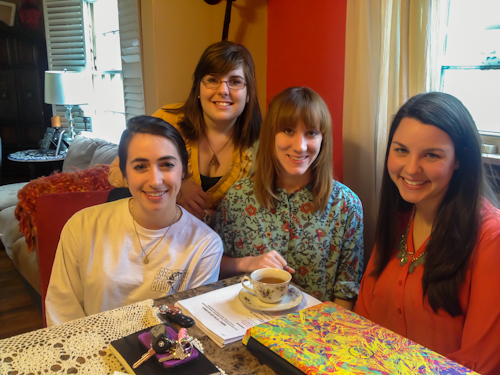
Pictured: Spring 2013 Clearly Delicious Interns for Editorial / Writing. From Left to Right: Erica deVeer, Tara Hebert, Amy Laws, and Meredith Quinn.
At the end of January, I posted several online listings for our spring internship positions at Clearly Delicious: Craigslist, Good Food Jobs, and the LSU English Department’s listserv where I invited area students to apply for our programs in Editing & Writing or Marketing & PR. The response was pretty outstanding, and I could not have anticipated the number of e-mails from enthusiastic and ready-to-learn students within such a short period of time.
For me, these requests affirmed something I already knew: blogging and writing for the Internet are here to stay.
Or, more importantly,
Online Journalism, Digital Media, and Blogging Are Here to Stay (re: food).
Not that I was terribly surprised.
But, what did surprise me was the number of English, Communication, and Public Relations Majors at LSU that wrote in with a passion for online media. When I was receiving my Bachelor’s Degree in the early-to-mid 2000s, I could never have anticipated the role the Internet would one day play in conversations of food and culture. I thought about my major in terms of books, magazines, and newspapers, but never in the unknown, permeable boundaries of food writing on the Internet.
Today, I no longer think of the Internet as a place where I Google images hoping to find stock photos for last-minute PowerPoint presentations. Rather, I’ve begun to appreciate the Internet’s massiveness in which thousands of websites go up each day (and 72 hours of videos are uploaded to YouTube each minute). Certainly, there’s inexhaustible amounts of information out there (of which, we should be in awe given how unbelievably young this kind of technology actually is), and there’s a growing distinction in our field about what separates the “Internet” from the “web.”
Signe Rousseau points out that the “web” is just “one model for sharing information on that network [the Internet]” and what I do, and what my interns hope to join and continue, is the quality and community sharing of a specific kind of information. Today, at this blog, we’re concerned with matters of food–recipes, family stories, great places to eat–but tomorrow, one of these young ladies may very well become the great blogger of buttons, DIY ideas, or any number of Pinterest-loving possiblities.
As we begin the first weeks in our spring program, I keep thinking how today’s Internet is not my Internet: an Internet where I actually felt comfortable posting bathing-suit pictures on spring break and wrote openly about my life on my friends’ Myspace pages or Facebook walls (yes, remember that thing called Myspace?).
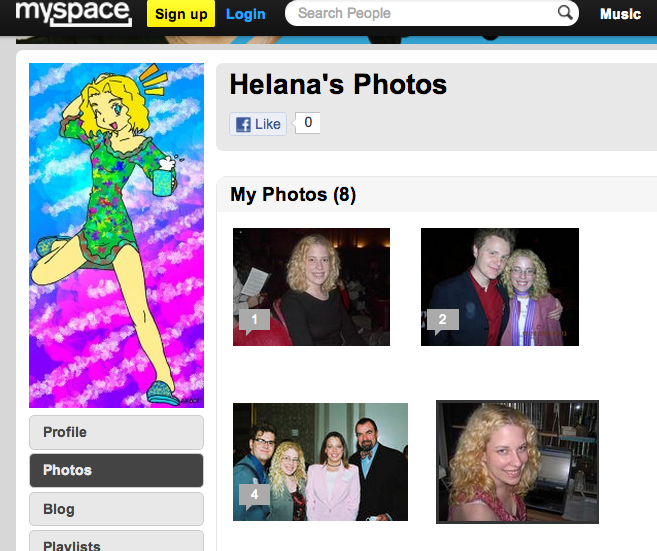
Pictured: a screen capture of my old (now defunct) Myspace page. Today, these pictures are almost 10 years old (insane and incredible to image), and I’m about 18. During this time, social media encouraged you to post whatever you wanted – here, a picture of me at a play, me with my favorite musician, David Mead, me and a few recipients of the Horatio Alger National Scholarship (yes, that’s Tom Selleck, and yes, he donated money to my college scholarship fund), and, last, somewhat ironically, me with my first PC laptop at my very first summer internship with Wally’s World of Entertainment in 2004. I actually remember saying to Wally Saukerson (the company’s owner), “HEY! We should get a Myspace page!”
During the days of “My Internet,” we had a presence (and somewhat of a voice), but no one outside of our immediate friends and family (seemed) to know who we were. Today, everyone everywhere is capable of accessing yours or my lives, and it’s especially important that we think before we post pictures and tweets. As Signe Rousseau cautiously advises in Food and Social Media: You Are What You Tweet (2012), we access, every day, a
“Sweet but Sticky Web.”*
Let me put it this way:
In ten years, I’ve seen wireless Internet become practically accessible anywhere (that’s right Linda, you know who you are) where wifi cards the size of Gameboys had to be jammed into our laptops and didn’t quite work. In truth, I had no idea what I was doing on the Internet in 2004 or 2005. Or even in 2008. I simply wrote, photographed, and published whatever I wanted, disseminating words and images as my current judgment saw fit. The Internet was just the Internet…no “web” here. I had no idea who might actually be reading my content, and no one ever told me a thing about photo editing or thinking twice about opinions and commas.
That was “my Internet,” and this is now.
As a teacher, I am proud to see a new generation of writers so quick and ready to join these larger publishing, thinking, and online community trends. As Serious Eats Founder, Ed Levine, famously vocalized (and I paraphrase):
“Twitter didn’t kill Gourmet. Gourmet simply couldn’t keep up.”
It is on Levine’s note that I introduce you to the new interns at Clearly Delicious and an overview of how we’ll be structuring our internship this spring (lots more information and posts coming). Each intern will work through the Clearly Delicious 6-month program learning important tips, tricks, and information about our field (whether print, online, or other) and contribute to the brand’s notes as they make their own personal discoveries and apply these skills.
It is my hope, as both a writer interested in online conversations of foodways and culture (as well as a teacher), that each student will find the program educational and informative. Look for their faces and contributions to the website over the next six months, but, for now, here’s a look at their program as they do the work towards becoming serious bloggers.
What You Need to Know about the Program:
– Consists of 2 tracks: Marketing / PR and Editorial / Writing
– Set over the course of 6 months (5 hours a week) with 3 stages. Each stage is meant to guide student interns as they work their way through a crash courses in blogging, editing, and writing basics both online and in print.
*Stage 1, “Basics & Foundations”
* Stage 1 introduces interns to the differences between writing and publishing for print media vs. online media (as with Clearly Delicious). This can be as wide as the ranges between the AP style guide to MLA to Chicago (and the similarities, values, and differences between them all).
-We also cover a list of productive food vocabulary, food vocabulary “no nos,” and things to look for in the Clearly Delicious writings specifically.
-Students gain access to WordPress basics, how to use front and back ends, and recipe writing as a genre and its stylistics.
*Stage 2, “Application, Application, Application”
* Stage 2 gives interns “hands on experience” in which they take their newfound knowledge from stage 1 and apply it independently to a variety of posts, pages, and articles. We meet at the beginning and end of each week to assess short-term goals and check in on the progress towards these goals. Interns also collaborate on posts together, comparing notes on how and why certain revisions or changes should be made.
*Stage 3, “Honing Your Edge”
* Stage 3 invites interns to “hone their edge,” or practice the areas of writing and editing they find most important to their future goals. Interested in copyediting? Food Writing? The AP wire? Huffington Post-like journalism? We’ve got plenty of that, and better yet, we invite our interns to author and publish their own posts for bylines, experience, and accreditations.
—
Interested in meeting the new interns? Visit our About Page (scroll to the middle/bottom) and see who’ll be working with us for the next six months.
Welcome all! We’re so happy to have you!
—
*page ix from Food and Social Media: You Are What You Tweet.
—
Follow me on Pinterest: http://pinterest.com/helana/
Twitter: https://twitter.com/DancesWLobsters
Facebook: https://www.facebook.com/pages/Clearly-Delicious/103136413059101
Tumblr: http://clearlydelicious.tumblr.com/
Purple, Gold, and GREEN: Creamy Saffron Bamboo Rice with Cardamom
February 10th, 2013loading...
Thank you to everyone who voted for my recipe in this year’s Marx Foods Recipe Contest! My Award-Winning Recipe for the “Easy Being Green Challenge” follows, featuring Creamy Saffron Rice, fragrant Cardamom, and a pinch of just the right amount of cinnamon and black pepper in this vegetarian take on Spanish-style Paella.
Whether you’re in Louisiana this Mardi Gras season or appreciating our festivities from afar, welcome to my kitchen where purple, gold, and green are always in season.
—
This weekend kicks off the Mardi Gras season in Baton Rouge, LA, and everywhere you look it’s all—
Purple . . . Gold . . .

Pictured: dancers at the beginning of the float lines for Saturday’s Spanish Town Parade. (Shot with a 24/70mm lens by Sigma. For more pictures, see here.)
and GREEN.

Pictured: a party-goer dressed in green caught my attention mostly because his camera matched his shirt. Photo taken Saturday at Baton Rouge’s Spanish Town Parade. (Shot with a 24/70mm lens by Sigma. For more pictures, see here.)
Last year, I posted Alison’s Green Juice Detox to remind revelers that although the holiday may have us indulging every way we turn, the days leading up to Lent don’t need to be entirely cake and beer. Rather, green foods, late winter citrus, and post-holiday detoxes make for great ways to return to “normal” (whatever our version of “normal” may be….).

Pictured: krewe float guards even participate in the celebrations by dressing up in crazy (often themed) costumes, as seen this past Saturday at the Spanish Town Parade. (Shot with a 24/70mm lens by Sigma. For more pictures, see here.)
Although February in Baton Rouge is uniquely special to our pre-Lenten indulgence, I still need a little bit of green. I’ve been eating kale, swiss chard, and spinach more than any other month this year, and I think high-iron greens are the way to go when it’s a little bit chilly and we may not be making the best nutritional choices (as seen, somewhat shamefully, here).
Last month, Justin Marx of the Seattle-based company Marx foods and past recipes (here, here, and here) sent me and a few other bloggers some green foods – dill pollen (fascinating stuff with twice the power of regular dill), crystallized mint, green lentils, and my favorite: bright green bamboo rice and whole cardamom.
The challenge?
“Pick two ingredients for a recipe of your choice to be voted on in this year’s Marx Foods Challenge.”
My response?
“Bring on the green!”
If you’ve ever seen bamboo rice in person, it looks more like jewelry than a grain. And cardamom seeds have this lovely pistachio – esque quality that demands you consume them immediately (note: these are a spice, not a nut, just so we’re clear).
Plus, one of the perks of using whole cardamom seeds comes from their subtler flavors than a version of ground cardamom you might buy at the store. Whole seeds elegantly infuse a dish without over-powering a larger school of spices or playing too-dominant of a role.
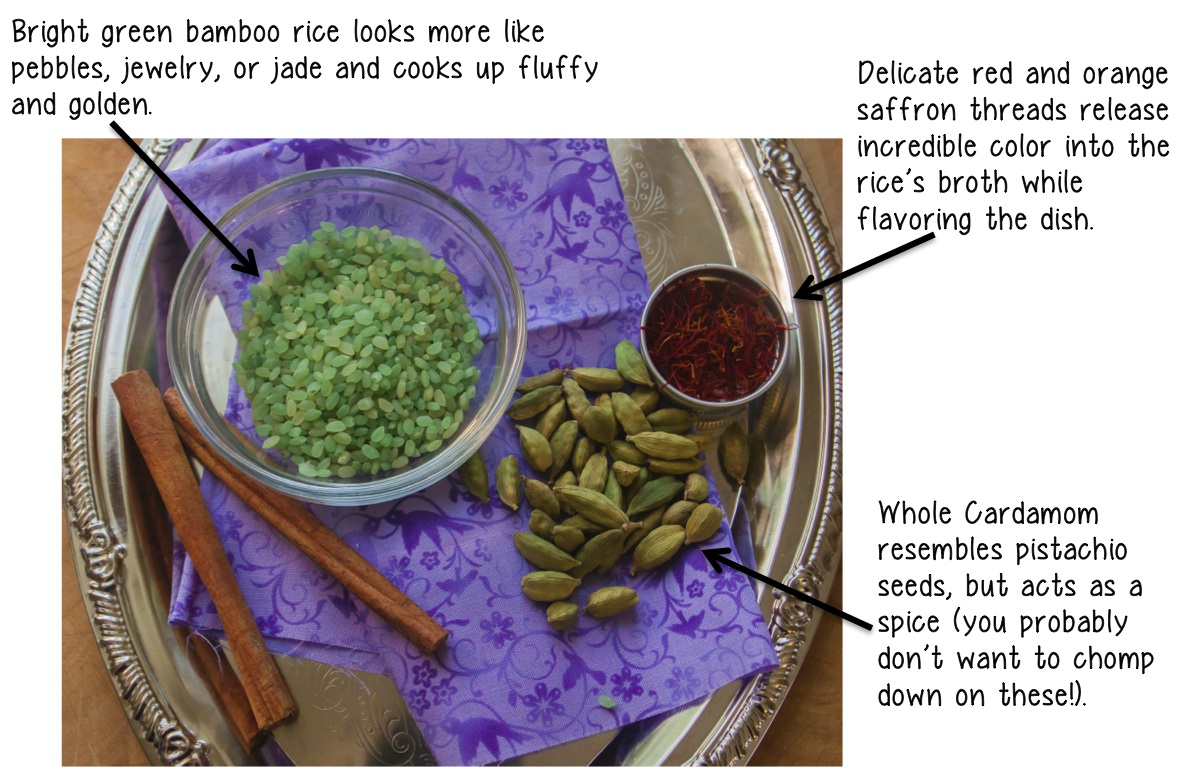
Pictured: my mise en place—bright green bamboo rice, whole cardamom, cinnamon sticks, and saffron. (Shot with 24/70 by Canon with Rhett’s Canon 5-D Mark ii.)
For this year’s recipe challenge, I thought it would be appropriate to revisit some of the foodways of past Louisiana Creoles – those of the Spanish settlers who are responsible for our later use of peppers, tomatoes, exotic spices, and grains in Creole cooking.
My take on a Spanish-style saffron rice includes Marx’s bamboo rice and cardamom seeds dressed in sliced green onions with bright purple-bulbs (I’ve only seen these in Louisiana).
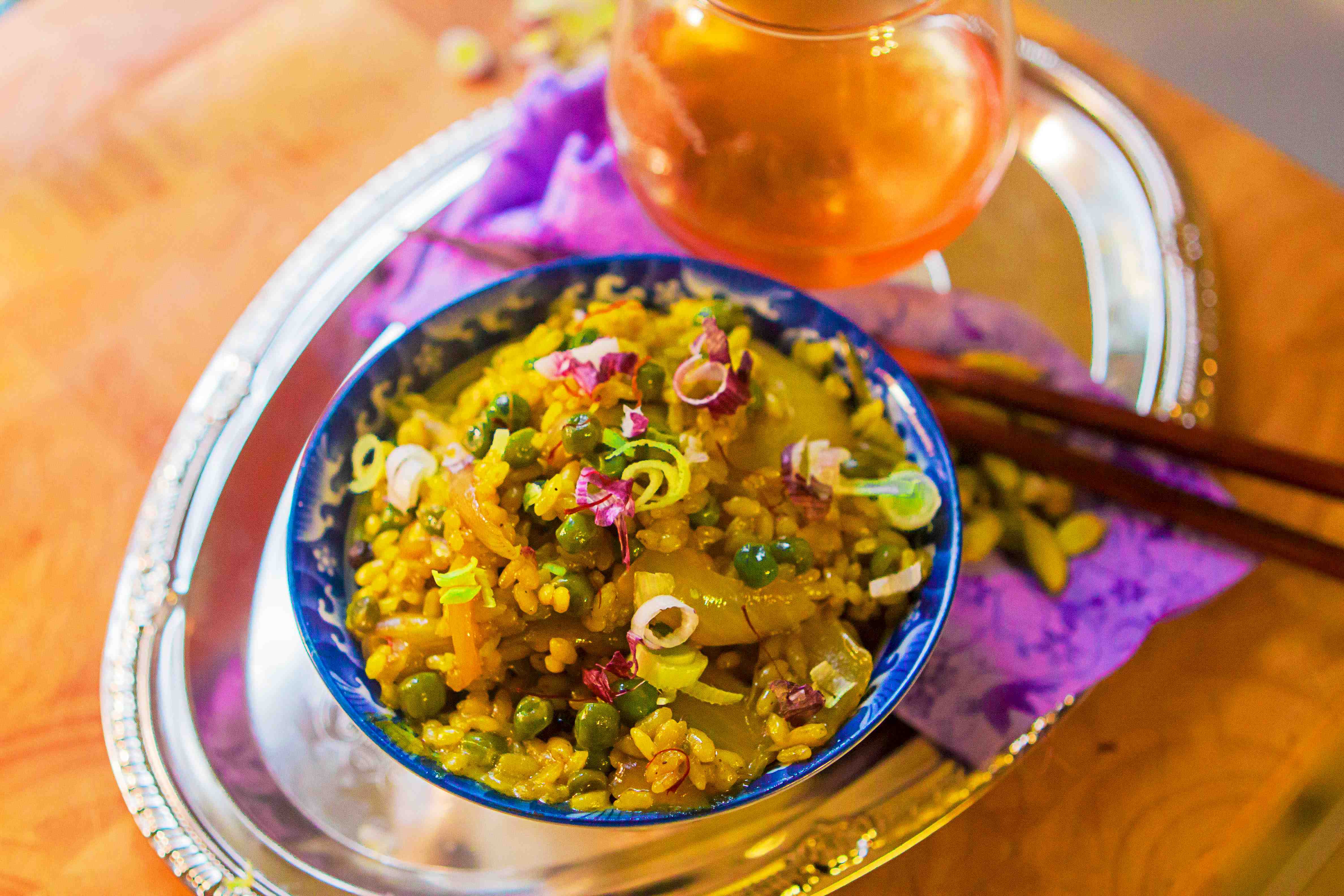
Pictured: Creamy Saffron Bamboo Rice with Cardamom, an easy way to serve purple, gold, and green all year round. Green peas, bamboo rice, and green onions with bright purple bulbs create seasonal colors with natural ingredients.
Since watching an episode of Gwyneth Paltrow and Mario Batali’s cooking show, Spain on the Road Again (one of the only episodes I could get through), I’ve had a hankering for authentic Spanish rice flavored with saffron. Paella in its original version uses prawns and tomatoes to add body and flavor to the dish. (Simply mute the TV show’s chefs and enjoy the cooking; or, as my GMAIL account has recently been want to do, put the GOOP e-mails in your “SPAM” folder.)
Here, I’ve substituted the basmati or bamboo rice for Marx’s green bamboo rice. I like the way it tastes and the dyed rice’s effects upon cooking: bamboo rice simultaneously diffuses green shades throughout the dish while absorbing the red and orange hues saffron releases when steeped in boiling water (or broth, which is more flavorful).
In the Spanish tradition, I finished the dish with peas, sautéed, sliced onions and garlicky green onions picked up at last week’s Farmer’s market. This surprising combination of spices makes for an unforgettable take on purple, gold, and GREEN.
Vote for my Creamy Saffron Rice with Cardamom in this year’s recipe contest – It’s Easy Being Green!
We won!!! Thank you to everyone who voted!
Creamy Saffron Bamboo Rice with Cardamom
Yield: 6 servings
Calories: 277.9 (see here for full nutritional information)
Prep Time: 5 to 10 minutes
Cook Time: 50 to 55 minutes
This recipe is prepared in the Spanish style in which saffron, peas, and quality rice make a side dish filling enough for a main course. A version of Paella for Spain, On the Road Again can be found online here and suggests some other ways this dish could be made even more flavorful with prawns, tomatoes, and authentic Spanish paprika.
Ingredients:
* 1 ½ teaspoons saffron seeds
* ¼ cup water, boiling
* 13 cardamom seeds (can substitute 1 1/2 – 2 teaspoons ground cardamom, to taste; cardamom seeds are by far much milder than the ground version)
* 4 cinnamon sticks
* 1 teaspoon ground cloves
* 10 black peppercorns
* 6 tablespoons salted butter
* 1 onion, sliced
* 1 cup green bamboo rice
* 1 cup green peas (frozen is fine)
* 2 cups chicken broth
*1 teaspoon kosher salt, plus more to taste
1.) Bring ¼ cup water to a boil and add saffron seeds. Reduce heat to medium-low and simmer for 10 minutes. Remove from heat.
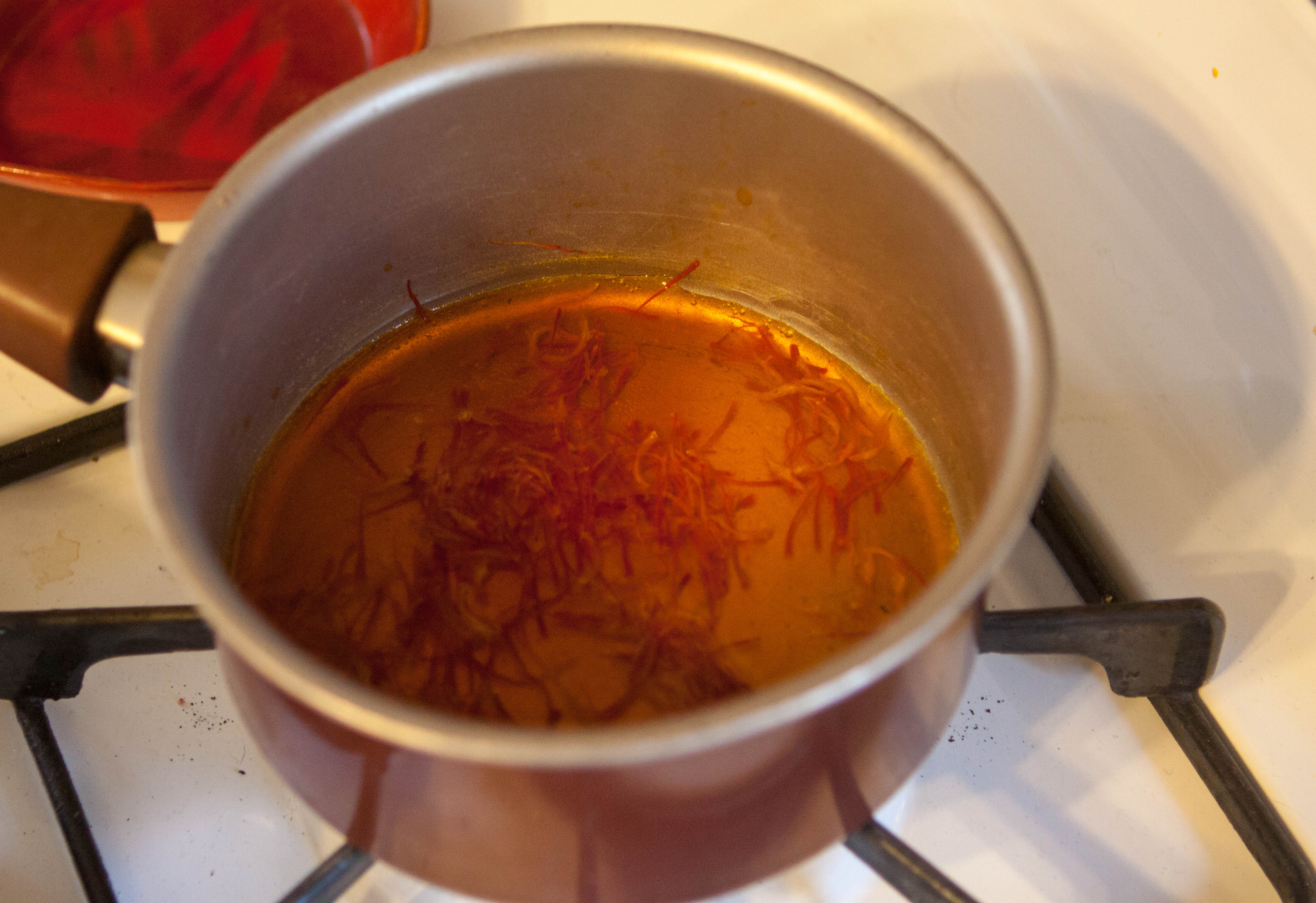
2.) Melt butter over medium heat and add cardamom, cinnamon, cloves, and peppercorns. Sauté for 3 to 5 minutes and add sliced onions. Cook onions until tender and beginning to brown.
3.) Add bamboo rice and toast for several minutes, stirring occasionally.
4.) Add peas, saffron mixture, chicken broth, and salt. Cover and cook for 25 to 30 minutes, stirring regularly to keep rice from sticking to pan.
5.) Before serving, add more salt to taste. Optional: remove peppercorns and cardamom before serving (or, just warn your dinner guests; I find that no one really likes to bite into an entire peppercorn seed…not intentionally, anyway!).
Makes 6 servings.
—
Follow me on Pinterest: http://pinterest.com/helana/
Twitter: https://twitter.com/DancesWLobsters
Facebook: https://www.facebook.com/pages/Clearly-Delicious/103136413059101
Tumblr: http://clearlydelicious.tumblr.com/
Shrimp Bisque by Denicola’s Foods
February 7th, 2013loading...
I hardly ever make anything from a packet. I make my own broths, grow some of my own herbs, and always, always, always make foods from scratch. At least, until recently.
On a past visit to Red Stick Spice Company, the owners of Denicola’s Foods were serving samples of their Crawfish Bisque and Pastalaya as I shopped for spices. Originally, I turned down the sample since I wasn’t hungry but was encouraged by a friend that I should “just have a taste.”
I did.
Several sample cups later, I was stuffing the Denicola’s bisque mix into my already full paper bag and taking it home for dinner. After a long day, I wasn’t particularly looking forward to all of the prep work I had waiting in this homemade chowder, and a quick and easy, “Mom on the Run”-type meal was in order.

Pictured: Shrimp Bisque using pre-packaged bisque mix by Denicola’s Foods. Just throw together the packet’s ingredients with water, corn, cream, and your choice of crawfish or shrimp and experience restaurant-style bisque in just a few minutes!
The pre-packaged bisque required only a few ingredients: water, canned corn kernels, a little bit of cream, and Gulf seafood. The process? Unbelievably easy. Simply bring each ingredient together in gradual steps (making sure not to boil the mixture), and a seafood bisque suddenly appears.
What I can appreciate best about pre-packaged foods is the ease with which a recipe can be made and the lack of self-doubt when tasting the final product. Unlike a homemade soup or stew that’s prone to scorching or too much salt, Denicola’s Bisque contains all necessary spices with no guess work. No need to add salt, pepper, or Cajun spices: Denicola’s has it taken care of for you.
Although I’m certain I’ll continue to be a stickler for homemade foods, I’m learning to appreciate when pre-packaged goods can make my life just a little bit easier (and tastier). That’s not to say this bisque can’t be personalized with a sprinkle of parsley or a dash of your favorite herb, but when the work has mostly been done for you, why not embrace the night off? I hardly ever make anything from a packet, well, except for this Shrimp Bisque.
Shrimp Bisque by Denicola’s Foods
Yield: 4-6 (5-ounce servings)
Calories: 306.4 (see here for full nutritional information)
Prep Time: 5 minutes
Cook Time: 15 to 20 minutes
Read below for my version of Denicola’s Bisque with Shrimp or see here for my article in Louisiana’s state newspaper, The Advocate.
Ingredients:
*1 (5-ounce) package of Denicola’s Bisque
*2 cups water, hot but not boiling
*1 (15.25-ounce) can corn kernels, drained (can use 8.75-oz can for less corn)
*1 (12-ounce) package frozen shrimp (can substitute crawfish), thawed and drained
*1 cup heavy cream (“whipping cream”)
1.) Warm water over medium-high heat until just before boiling. Add bisque packet to water and whisk to combine. Reduce heat to medium and simmer for 3 to 5 minutes.
2.) Add corn to mixture and stir to combine. Cook for an additional 3 to 5 minutes or until corn has warmed.
3.) Add shrimp and cook until pink, about 3 to 5 minutes (be wary of over-cooking!). Pour in heavy cream, combine with bisque and warm, but do not boil. Serve with crusty bread.
—
Follow me on Pinterest: http://pinterest.com/helana/
Twitter: https://twitter.com/DancesWLobsters
Facebook: https://www.facebook.com/pages/Clearly-Delicious/103136413059101
5 Things You Didn’t Know You Could Do with Butternut Squash: Butternut Squash Lasagna with Blue Cheese and Mozzarella
February 4th, 2013loading...
Ever since I posted this recipe for Creamy Butternut Squash Macaroni and Cheese, I’ve been thinking a lot about why and how we use butternut squash in our kitchens.
Traditionally, my family has always relied on the “it’s Thanksgiving!” mentality of roasting squash—pop that baby in the oven with some olive oil, salt and pepper, and serve it as a side dish to puckered-faced children who’d rather crawl under the table than eat a vegetable that color. Butternut squash isn’t orange like a carrot or yellow like a banana, but this weird version of the two (depending on its raw or cooked version, of course). Clearly, butternut squash is not to be trusted.

Pictured: “Can this butternut squash stuff be trusted?”
But, it’s also one of the more versatile squashes I’ve cooked with lately. I know I was skeptical when going into the macaroni and cheese recipe I mentioned above, but I was handsomely rewarded as Lydia and I both realized—
“I think…I think I like this better than regular macaroni and cheese?!”
In fact, if you know what you’re doing, butternut squash can be a wildly useful way of sneaking vegetables into food and using up that leftover squash that you just couldn’t find anyone to eat in one sitting.
This Saturday, I finished off the leftover butternut squash from my Creamy Macaroni and Cheese recipe (with butternut squash) for a lasagna that featured a similar concept: delicate lasagna noodles bedded between two cheese sauces (one blue and one ricotta-based) and strewn with sweetly-roasted butternut squash. The dish creates an unexpected take on vegetarian lasagna, and it’s not the only thing you can do with this squash:
-5 Things You Didn’t Know You Could Do with Butternut Squash-
1.) Substitute Butternut Squash for Cheese in a Béchamel Sauce.
This idea surprises so many people (including me)—but, when steamed and boiled with the right ingredients (say, a little broth, milk or cream and spice), butternut squash absorbs and develops an incredible amount of new flavors that are noticeably lighter and less identifiable than the earthier tones you’d find if eating squash by itself. The key in this process is to slow cook, tenderize, puree, and blend so that the final product sneaks butternut squash into a place it typically wouldn’t be—half of the sauce you’re pouring over your Macaroni and Cheese or any kind of pasta noodles.
Example: Creamy Butternut Squash Macaroni and Cheese
Example: Butternut Squash Rigatoni
Example: Butternut Squash Creamy Pasta
Example: Butternut Squash Sauce (just the sauce recipe, but suggests cheese be added later as a topping)
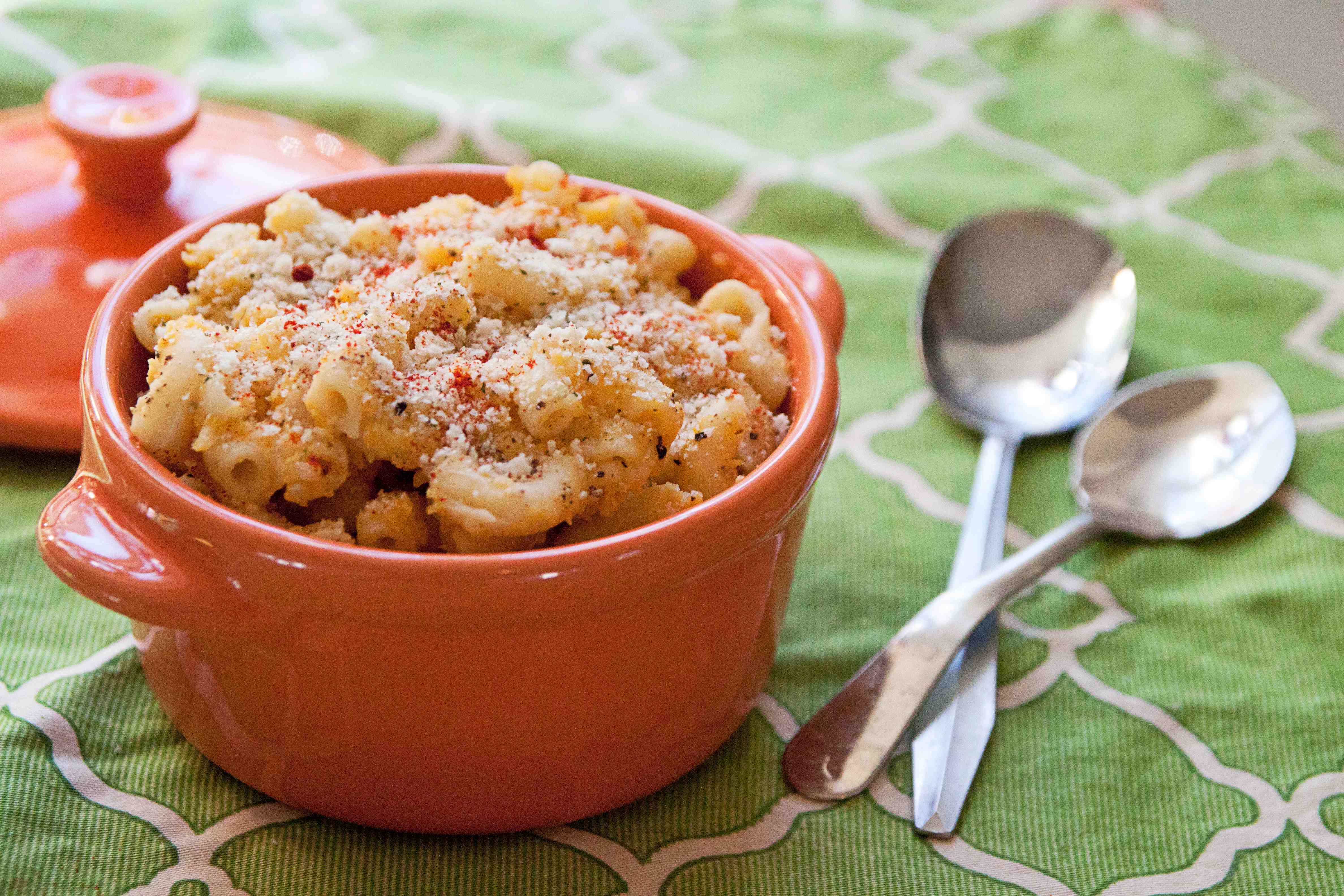
Pictured: just an example of how much you can do with butternut squash: Creamy Butternut Squash Macaroni and Cheese.
2.) Substitute Butternut Squash for Meat Toppings (as with Pizzas, Lasagnas, and Crostini)
#2 really comes down to personal choice and taste preferences (ok, and also how much people are willing to try something new). If you love bacon on everything (like me), you may find it hard to swap out the salty pork stuff for orange-colored squash, but the substitution does have its benefits: besides the clear low-calorie perks, butternut squash blends beautifully with cheeses that can be subtle (like ricotta) or sharp (like blue).
Of course, I am not asking that you substitute butternut squash for every kind of meat (nor should you! Butternut Squash Sloppy Joes? That’s not a great idea), but be open to the vegetable’s flexibility as a healthful, creative, and satisfying substitute that will make your friends and family think about the food you’ve placed in front of them.
Example: Butternut Squash Lasagna with Blue Cheese and Mozzarella (recipe below)
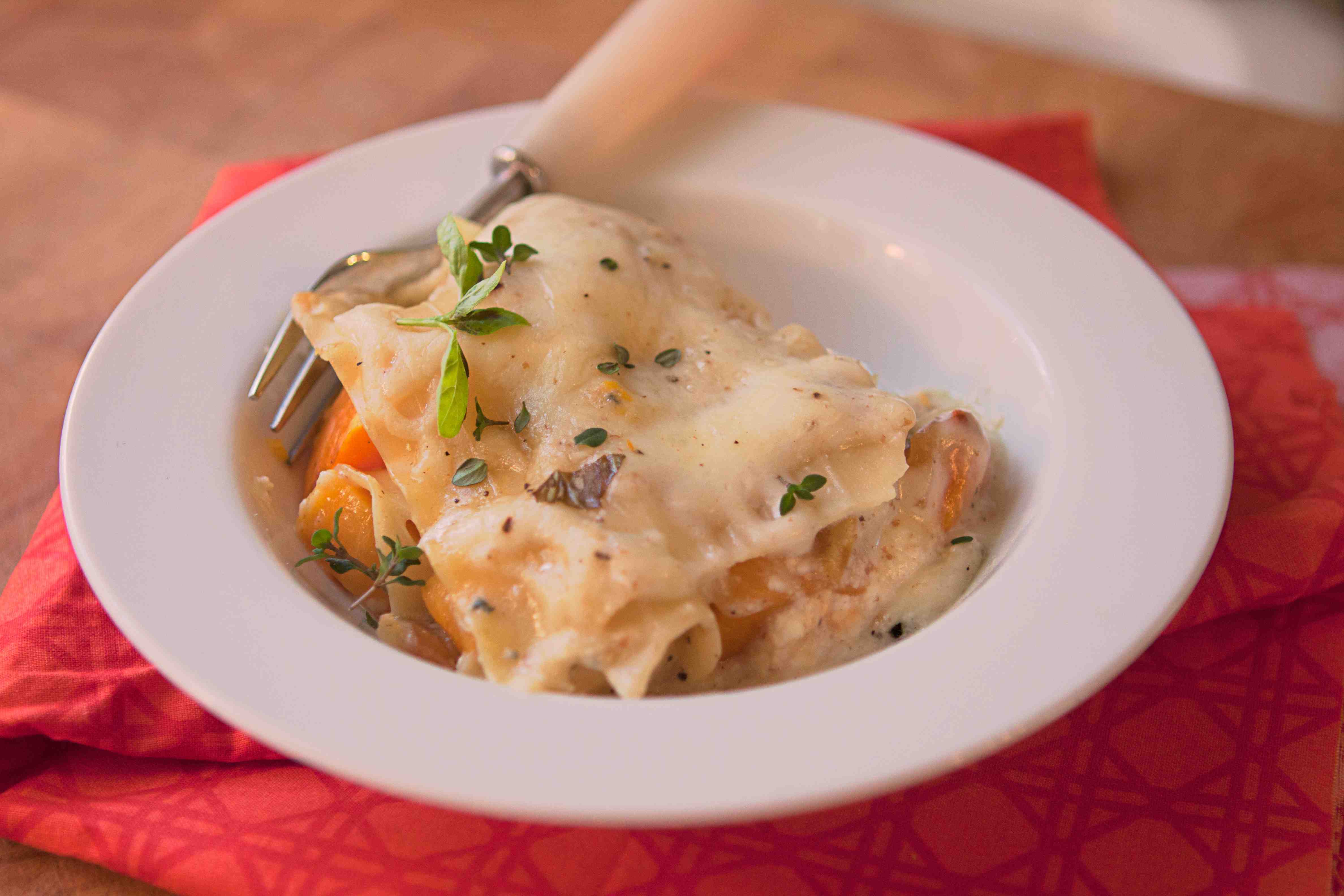
Example: Prosciutto, Kale, and Butternut Squash Pizza
Example: Butternut Squash Black Bean Tostadas
Example: Butternut Squash Ricotta and Sage Crostini
3.) Slice and Bake into Vegetable Chips
Vegetable chips, although wildly expensive at Whole Foods and specialty grocers, are actually remarkably cheap and easy to make at home. Simply buy the vegetable and get to slicing, but be careful not to let your chips “burn” once popped in the oven (a Silpat mat always helps). Mandoline slicers are great go-to tools for homemade chip recipes (and work well), but I always tell cooks to be wary of the somewhat hidden and sharp flat blade.
Tip: if you use an oven mitt or industrial glove when slicing, you’re less likely to cut your fingers and hands. Trust me, you’ll want to try this!
Example: Parmesan Butternut Squash Chips
Example: Butternut Squash Chips with Sage
4.) Serve for Dessert in Custards, Puddings, and Pies
#4 shouldn’t be as much of a surprise as the others—squash in general has a long history of being slow roasted, pureed, and double-baked into a flaky pie shell (ahem, ahem, American pumpkin pie). Butternut squash, although somewhat more flavorful than a pumpkin, has a lot to offer when preparing dessert.
Not only does a cooked and processed butternut squash bring its own level of earthiness and surprise to any dessert item, but it complements traditional fall spices like nutmeg and cinnamon in a way that many palates can appreciate and easily identify. Whereas pumpkins commonly take on the flavor of their recipe counterparts (I think Bobby Flay does a great job of explaining this idea here), butternut squash never really “impersonates” anything: it’s always butternut squash, but it’s sometimes a little bit better, say, Butternut Squash with Cinnamon, Ginger, and Orange as with the Custard recipe below.
Example: Butternut Squash Custard
Example: Bourbon Butternut Squash Chutney
Example: Butternut Squash Pie
Example: Butternut Squash Pudding
5.) Convert into Pasta
Last spring, I made pasta using roasted beets. They were ruby red, beautiful, and tasted nothing like beets. Like substituting fatty cheeses when making a béchamel sauce, butternut squash (like the beets recipe I mention here) can add flavor and color to an otherwise egg-based dish.
So, whether you’re using pureed butternut squash to thicken and enhance the sauce you serve with your pasta, or using it to add nutrition and creativity to the pasta itself, butternut squash has a range of applications that might just surprise you.
Example: (Basic) Butternut Squash Pasta
Example: Homemade Butternut Squash Pasta Tutorial
Example: or, get creative: peel the squash into “pasta”: Butternut Squash “Pasta” Caesar Salad
And, if you can’t seem to eat it? Why not carve it next Halloween? (Scroll down to a few images for a rather full-length skull).
Butternut Squash Lasagna with Blue Cheese and Mozzarella
This recipe takes butternut squash from side dish to main course with just a few tweaks to a traditional lasagna recipe featuring blue cheese. Create two cheese sauces—one with ricotta and one with blue cheese, and roast butternut squash with an onion until tender. Combine into a layered lasagna for a new and attractive blend of flavors!
Yield: 6 servings
Calories: 423.4 (see here for full nutritional information)
Prep Time: 20 minutes
Cook Time: 50 to 60 minutes
Ingredients:
*5 cups butternut squash, peeled, seeded, and cubed into 1-inch pieces
*1 yellow onion, chopped
*1 tablespoon olive oil
*Salt and pepper, to taste
*1 cup ricotta (whole—not low-fat or skim—is best)
*1 egg
*1 teaspoon salt
*1 teaspoon pepper
*2 tablespoons butter
*1 tablespoon whole wheat flour
*1 tablespoon all purpose flour
*1 1/2 cups milk (skim works fine)
*1 cup blue cheese
*10 ounces lasagna noodles (about 10 or 11 strips), cooked according to package instructions
*2 tablespoons fresh basil, chopped (can substitute 1 tablespoon dried basil)
*2 tablespoons fresh sage, chopped (can substitute 1 teaspoon dried sage)
*3/4 cup shredded mozzarella
*Salt and pepper, to taste
SPECIAL EQUIPMENT NEEDED:
*Silpat mat
*9.5 x 12.5 casserole dish or like baking dish (somewhat deep, 4-5 quarts)
1.) Preheat oven to 375F. Toss butternut squash and onion together with olive oil and salt and pepper. Spread across a Silpat-lined baking sheet and roast for 30 minutes (flipping occasionally) or until squash is tender to the piercing of a fork.
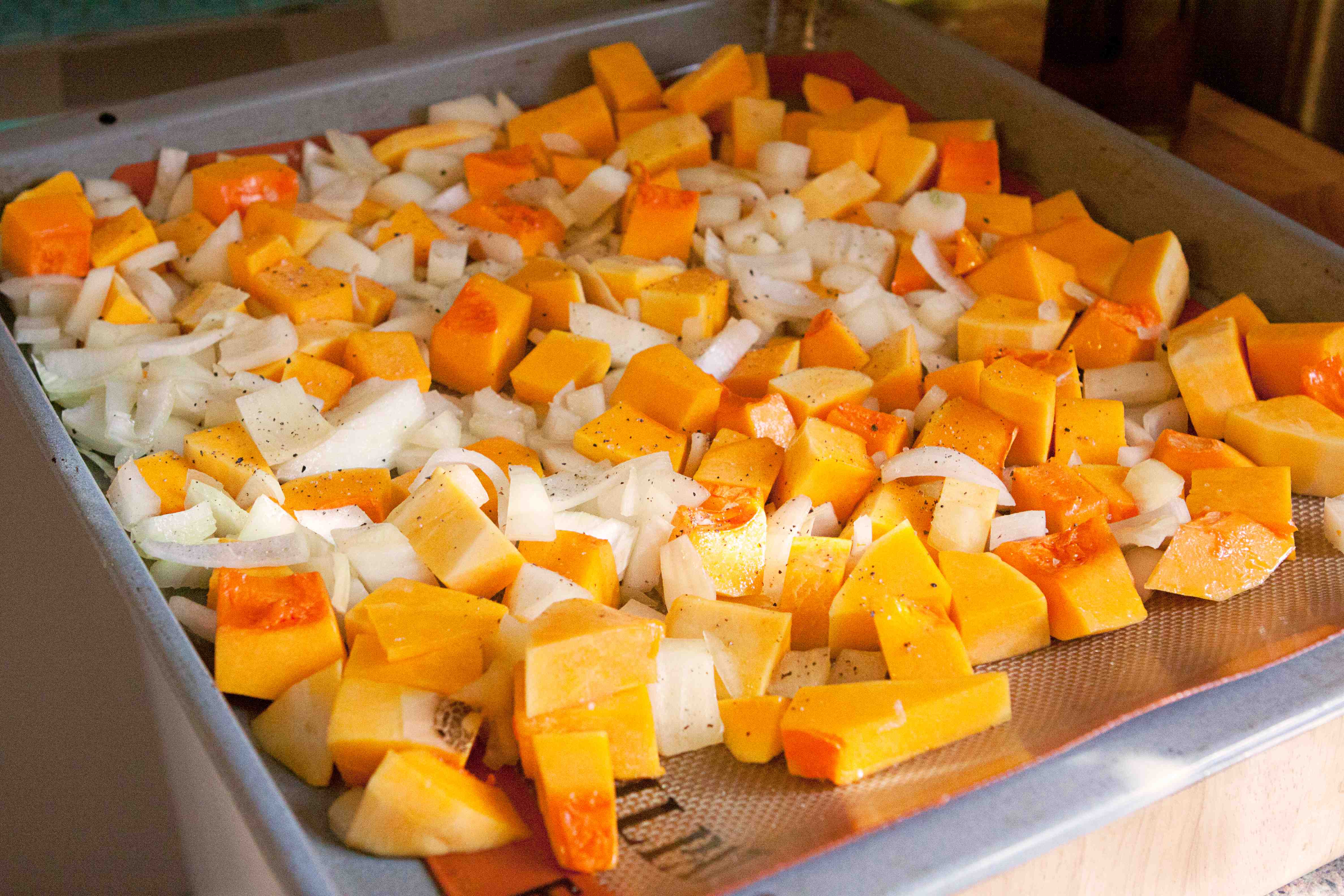
2.) Prepare ricotta sauce: mix ricotta with egg and salt and pepper. Set aside for assembling lasagna.
3.) Meanwhile, cook lasagna based on package instructions (al dente—tender, but a little firm). Remove from heat and strain.
Tip: if your pasta is done significantly earlier than the squash and blue cheese sauce, remove it from the burner and let it rest in the pasta water. So long as the pasta is removed from a heat source (that could encourage it to continue cooking) and has truly been cooked al dente (with some firmness to it, but still done), the pasta will not over cook. Strain right before use.)
4.) Prepare blue cheese sauce: melt butter in a nonstick, medium-sized saucepan over medium heat. Whisk in both flours and cook for 1 minute to give the flour a nutty flavor. Slowly whisk in milk and stir occasionally until mixture thickens. Remove from heat and stir in blue cheese.
5.) Grease casserole dish with nonstick spray and spoon several tablespoons of the blue cheese sauce and ricotta mixture over the bottom of your pan. Lay several lasagna noodles flat across the surface and spoon with more blue cheese sauce. Add half of your butternut squash and onion and dress in half of the ricotta mixture. Assemble next layer in the same order: lasagna noodles, blue cheese sauce, the rest of your butternut squash, ricotta, and lasagna. On the third layer, cover with any leftover cheese sauce (ricotta and/or blue cheese) and sprinkle all over with mozzarella. Sprinkle with salt and pepper and a little bit of basil and sage.
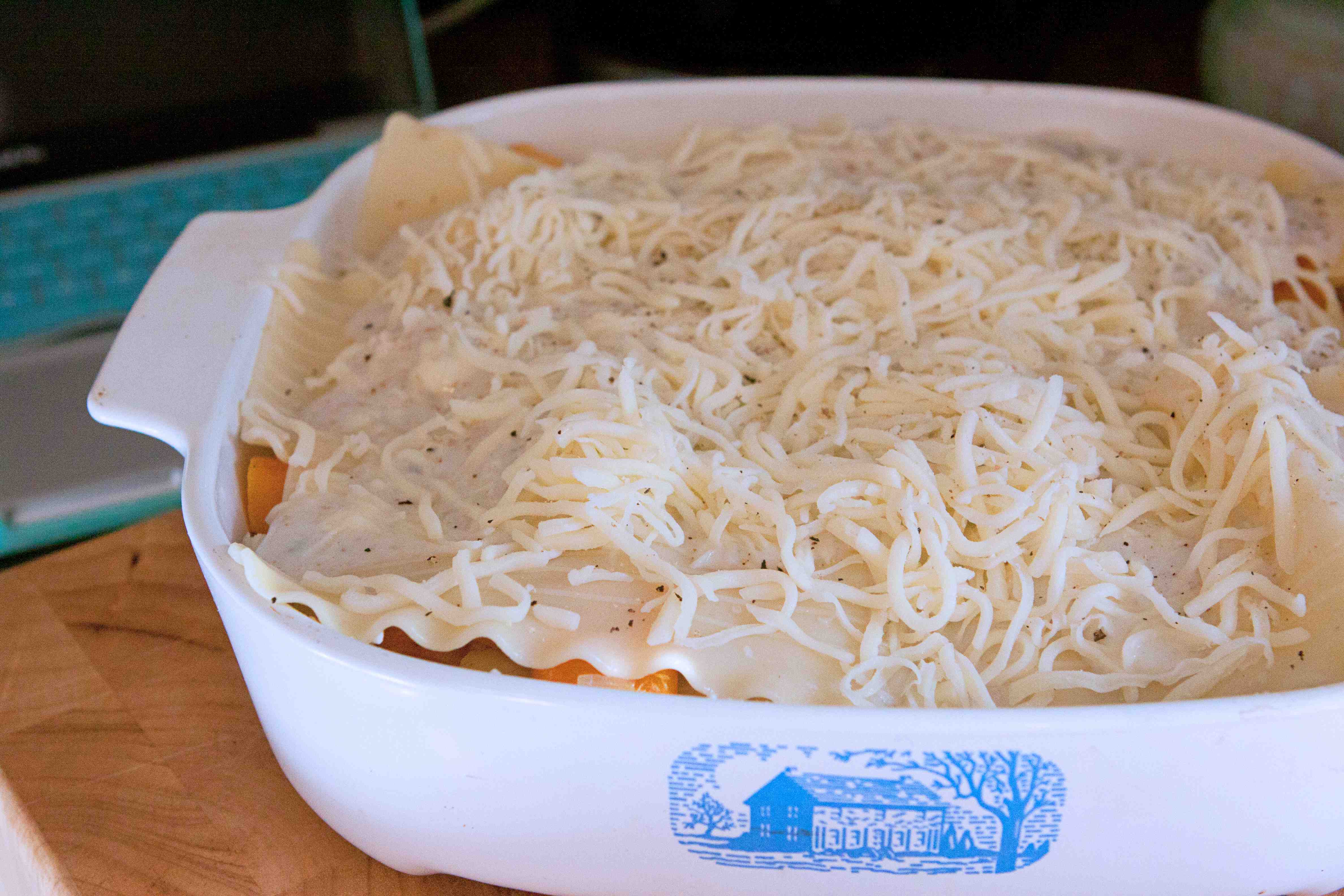
6.) Bake in oven for 25-30 minutes, or until top of lasagna is golden and bubbly. Remove from oven and rest for 5 minutes before serving.
Makes 6 servings.
Tip: as with pizza, lasagna should also be given at least five minutes to rest before serving. This way, the dish isn’t incredibly hot and doesn’t slide all over the place when you plate it and holds together.
—
Follow me on Pinterest: http://pinterest.com/helana/
Twitter: https://twitter.com/DancesWLobsters
Facebook: https://www.facebook.com/pages/Clearly-Delicious/103136413059101
Tumblr: http://clearlydelicious.tumblr.com/
Adam Roberts: “10 Food Blog Posts That’ll Get You Traffic”
January 30th, 2013loading...
“Only A Jerk Would Eat at Le Cirq“ | “The Best Broccoli of Your Life“ | “Janet Jackson Breast Cupcake“
What do these seemingly random, but specifically titled articles have in common?
Adam Roberts.
Not just any Adam, but “Amateur Gourmet” Adam Roberts (of both the book and blog) as well as his new work, Secrets of the Best Chefs, a heavy and diverse tome of 50 American chefs that I believe will become one of the most accessible and diverse works out of which I’ve been lucky to cook (recipes coming soon for Butternut Squash Tortellini and Creamy Spinach-Stuffed Chicken!).
I realize this is a pretty heavy claim, and I’m definitely getting ahead of myself.
This past weekend, the Gumbo Goddess (Caroline Wolf) and I spent several days in Birmingham, AL, at the 2013 Food Blog South Conference. It was both Caroline’s and my first time attending, and we could not have enjoyed the variety of panels, people, and stories more. Everyone from Dianne Jacob of Will Write for Food fame to our keynote speaker, Kenji Lopez-Alt of Serious Eats, offered lively and interesting talks about working in the food blogging industry.

Pictured: packed standing room at Food Blog South 2013 of Hélène Dujardin‘s “Advanced Food Photography & Styling” presentation. Shot with a 10-22mm wide-angle lens for Canon.
Adam’s talk, “10 Food Blog Posts That Will Get You Traffic,” kicked off Saturday’s panels, driving home a lot of the ideas many bloggers forget when publishing: not just the important role community plays in our final products, but also the ways quality content defines traffic and readership.
Plus, he’s a pretty snazzy dresser as seen here (and here):

Pictured: Adam Roberts addressing Food Blog South 2013 attendees about the “10 Food Blog Posts That Will Get You Traffic.” Shot with a 24/70mm lens by Sigma.
The truth is, there’s a lot of conflicting advice out there, especially when it comes to food blogs and how we write or speak about food. On Friday, Lisa Ekus and Virginia Willis handed out a “Food Word Vocabulary” we could (no, should) feel free to use during TV/Radio Interviews and Cooking Demonstrations. On it–between the words “crunchy” and “earthy”—
The next evening, Kenji Lopez-Alt of Serious Eats quickly informed me that “delicious” was on the “Secret List of Banned Words” at his website (yes, a website that receives between 11-14 million unique visitors a month, and they are not using the word “delicious”).
[See note below on Ed Levine’s philosophy for Serious Eats.]
Two seasoned critics with two conflicting pieces of advice.
One panicked food blogger (ahem, ahem) that happened to name her blog with the keyword, “delicious.”
So, what do we do with the word “delicious?” It’s hard for me to say.
But, what I do know, is that as of March 2013, Clearly Delicious will be answering Adam’s call for “tough love” (yes, his words to me exactly) and renaming herself,
“Dances with Lobsters:
Clearly Delicious Recipes from the Coast of Rockland, Maine, to the Gulf of New Orleans.” .
[Adam, see what you made me do? My blog now has a sub-header!]
But I’m certainly not upset, and I say these comments with a smile, as I really do love the revamped title of this website, and I have Adam Roberts’s, “nobody’s gonna remember the name ‘Clearly Delicious'” comments to thank for this change. But why not scrap the terminology “clearly delicious” altogether? Especially when I’ve been advised by both the keynote speaker of FBS2013 and the Amateur Gourmet himself to drop it?
I think it’s because Clearly Delicious—whatever her manifestation—originated with the same principles that drove Ed Levine to found Serious Eats: a passion for “seriously delicious food,” dubbing himself, “the missionary of the delicious.”
In a language with almost 200,000 words printed in the OED last year, English-speaking tongues sometimes only have the word “delicious” to fall back on…especially if their mouths are full of pizza.
Ultimately, my (and Adam’s) point is: this hazy idea of what food blog writing should be is forever growing increasingly complex and [if I may rant for a second] superficial—glamorous photography, beautifully-plated food, somewhat hollow stories about cats and husbands where professionally makeup-ed women have clean kitchens and manicured nails before, during, and after dinner. Such images continue to enamor women readers like me and drive content trends (much to the chagrin of critics like Emily Matchar or Signe Rousseau).
In fact, there’s sort of a recipe for that kind of writing:
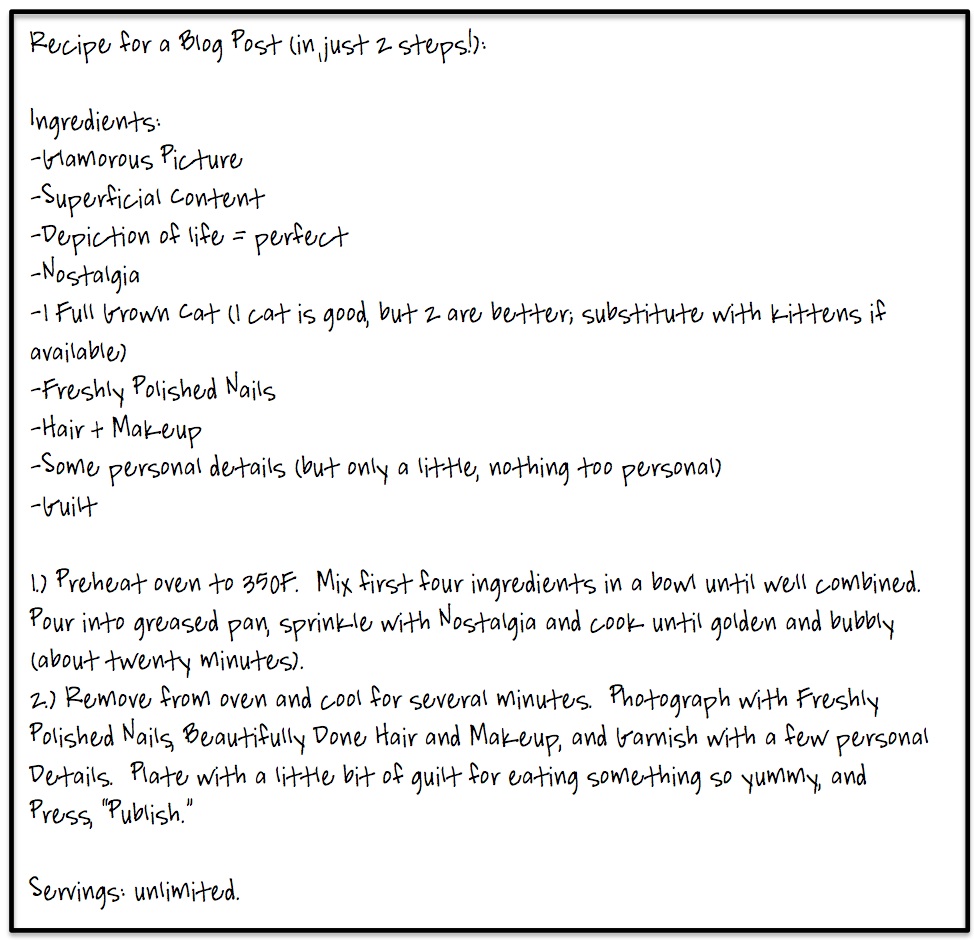
Pictured: a little something I put together that (I believe) encapsulates “bad” or “not great” food writing we often find online. I realize it’s a bit biting in its sarcasm, but I really believe we should be able to laugh at and identify these trends, especially when they begin to distract us from what food writing should really be.
And, I admit, I’ve fallen prey to these trends. In fact, I wasn’t originally planning on attending Adam’s talk because, during the car ride over, Caroline and I both agreed, “we know how to write good blog posts!” and thought the SEO / Maximizing Social Media / “App for That” presentation would be more worth our time.
But, happy accidents and good fortune have a way of changing whole experiences, and I was lucky enough to meet Adam the night before his talk while sharing drinks with Caroline and Kenji at the hotel bar. I, white wine in one hand and very little food in her belly, could not stop talking about lobsters, and he, immaculately matched between shirt and sweater, convinced me pretty immediately that his talk on “writing good blog posts” was something Caroline and I definitely needed to hear.
[I also think Kenji’s insistence that we attend was pretty convincing too…I can’t say, “no” to people who know what they’re talking about, nor should I.]
So, let’s get to it.
Going into Food Blog South, I had a clear vision of what I wanted to hear and see and what I didn’t. I couldn’t have anticipated my uber-fascination with technology trends would be pushed aside by an adorably interesting food blogger who has made his work out of his “amateur” status. The questions, “What is a food blog?” and, more importantly, “What makes it good?” have resonated with me since Adam’s talk and since the trip.
I’ve always prioritized quality when it comes to my writing (heck, I know I can cook, no question there, but can I write about food?). And what’s the “line in the flour” between a post someone will want to stop and read and a post someone will flip to the end of looking for pretty pictures?
I’m not sure if I quite know how to answer all of these questions yet, but I hope to return to them in future posts as Clearly Delicious goes through a series of necessary and exciting face lifts (make that a face lift, first botox injection, and tummy tuck plus thigh reduction).
Let’s trim the fat (if you will) and add some lean protein, antioxidants, and good, quality “fats” (like the kinds you eat in avocados). Let’s make Clearly Delicious a place where quality content is the mission statement of every post and not what’s “trending on Pinterest.”
It’s kind of like my relationship to running. As I was telling Russ Turley last night in our recording of Fat2Fit Radio (episode #142), I’m a long-time runner, but have sort of turned to the sport as a “lazy” exercise. I no longer burst with guns as seen here, but have become one of those, “Where my spanx at?!” girls since I stopped lifting weights. Quality (“trimming the fat”) at a blog, or anywhere, requires work.
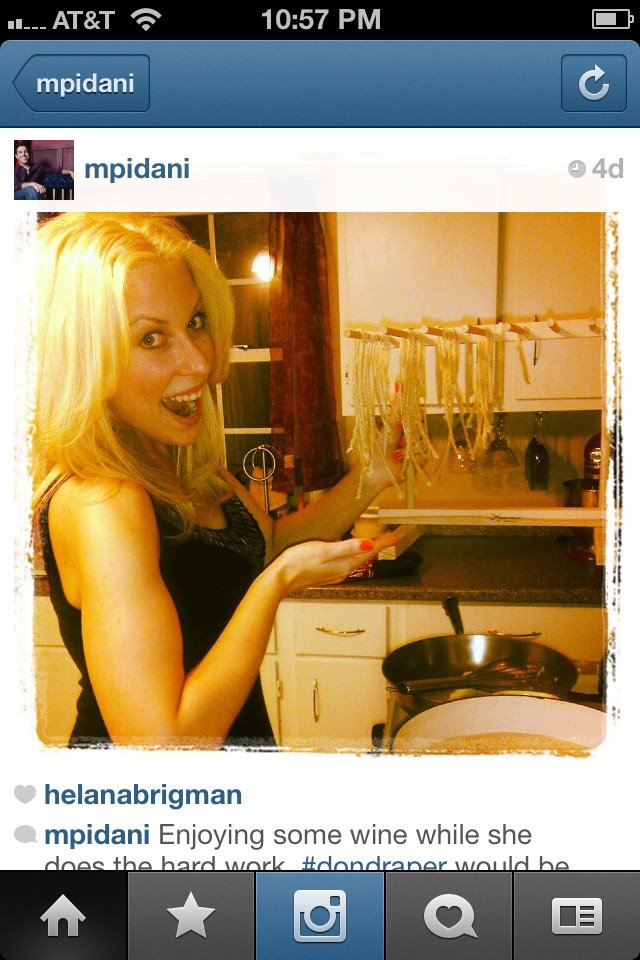
Pictured: me last spring, making homemade pasta for my friend Michael. I miss these arms…who said food bloggers can’t be buff?
Enough postulating and reflective thinking.
For a man with a plan (as well as a bulleted list), please read the very informative post on “10 Food Blog Posts That’ll Get You Traffic” at Adam’s website, Amateur Gourmet. For the bulleted breakdown (plus some examples) from my notes during his talk, then see below.

Pictured: Adam Roberts addressing Food Blog South 2013 attendees about the “10 Food Blog Posts That Will Get You Traffic.” Shot with a 24/70mm lens by Sigma.
“10 Food Blog Posts That’ll Get You Traffic” by Adam Roberts
Food Blog South, 2013, 9:00 a.m. – Saturday, January 26th, 2013
1.) The Beautiful Recipe Post
2.) Novel Post
3.) Pop Culture Post
4.) Carefully Researched Post
5.) “Eat Your Way / Cook Your Way through Something” Post
6.) List Post
7.) Creative Story-Telling Post
8.) Negative Rant Post
9.) Food TV Recap Post
10.) Emotional, Bare-Your-Soul Post
Phew! Got that guys? I hope so. I know I’ll be taking names and taking numbers in the next few posts to follow. Expect great things from Clearly Delicious, and if you haven’t done so already, be sure to check out Adam’s book, blog, and other book. He is a gem.
—
Follow me on Pinterest: http://pinterest.com/helana/
Twitter: https://twitter.com/DancesWLobsters
Facebook: https://www.facebook.com/pages/Clearly-Delicious/103136413059101
Tumblr: http://clearlydelicious.tumblr.com/
Creamy Butternut Squash Macaroni and Cheese
January 30th, 2013loading...
Last week, I had an epiphany.
It was a Tuesday night, I was pulling a casserole dish out of the oven, and my friend Lydia had come over for dinner.
7:00 p.m., exactly, was when I had my epiphany:
Creamy Butternut Squash Macaroni and Cheese.

Pictured: the real deal in Macaroni and Cheese makeovers—Macaroni and Cheese with Butternut Squash and Panko Bread Crumbs.
I’m not gonna lie, I was incredibly skeptical when I first started making it. Butternut squash (in my experience) can have an overbearing flavor when prepared incorrectly. Sure, it’s creamy, golden, and beautiful, but I can only eat so much without the help of a little butter.
But, as per my resolutions to figure out little ways to eat healthier, I had to try my favorite comfort food whether it meant vegetables or not.
What I love about this recipe is how incredibly simple it is to switch from the fat-laden world of two pounds of cheese (as with my past recipes here and here) to the more healthful world of half cheese, half squash. Bring the squash to a boil in milk and broth and let the steam do the tenderizing work. Once soft to the pressure of a fork, the squash can be puréed in a food processor (or blender) and whipped together with the cheese you will be using (no flour, butter, or oily roux here; just squash, cheese, and steam).
When we finally sat down to eat, I couldn’t get over the enhanced flavors in this dish. Normally, macaroni and cheese is a bit two dimensional—pasta + cheese. After a few bites, the palate fails to pick up on new flavors, and I know from experience that I tend to go on autopilot as I scarf down the starchy carbs.
But, in this version, the butternut squash brings life to other ingredients in the dish that may fail to be actualized when you’re tasting it. The macaroni only has a subtle “squash-like” flavor, and it’s noticeably lighter and heavenly, leaving less room for guilt when the plate is clean.
At one point, Lydia looked over at me, startled, and said, “I think I like this better than regular macaroni and cheese.”
I agreed emphatically.
Creamy Butternut Squash Macaroni and Cheese is not some health food fad version of a classic American dish. It’s something entirely different—it’s better…creamier…more flavorful. It’s something I can’t wait to make again.
Creamy Butternut Squash Macaroni and Cheese
Yield: 8 servings (about 1 1/2 cup each)
Calories: 375.5 (see here for full nutritional information)
Prep Time: 15 to 20 minutes
Cook Time: 50 minutes
This recipe transforms the basic homemade cheese sauce of a traditional macaroni and cheese with a healthy vegetarian-friendly twist: butternut squash. Where most recipes would ask that you use three to four cups cheese for the cream sauce, this recipe cuts the cheese in half and uses puréed butternut squash as a substitute. See below for how to make this revision.
Ingredients:
*5 cups butternut squash, peeled, seeded, and cubed into 1 to 1 1/2-inch pieces
*1 1/2 cups milk (I used skim)
*1 1/4 cups chicken or vegetable broth (use vegetable for vegetarian-friendly recipe)
*3 cloves garlic, minced or pressed
*1 teaspoon coarse salt
*1 teaspoon pepper
*1 (16-ounce) box elbow macaroni
*1 cup freshly grated Parmesan cheese
*1 cup crumbled blue cheese*
*Panko bread crumbs, for garnishing
*Note: not a fan of blue? Try switching your proportions to 1 1/4 cups Parmesan and 3/4 cup blue; or, substitute blue for you favorite mild or sharp cheese such as mozzarella or Cheddar.
1.) Peel, seed, and cube butternut squash, then set aside. In a nonstick, medium-sized saucepan, bring the milk, broth, and garlic to a simmer. Add squash and season with salt and pepper. Cover with a lid and simmer until squash is tender (about 20 to 25 minutes).
2.) Meanwhile, preheat oven to 350F and prepare elbow macaroni according to package instructions. Remember to keep the two rules of pasta in mind: 1.) the water should taste like “sea water” (so the pasta has flavor) and 2.) the pasta should be cooked al dente (firm, but still tender). Strain and reserve for cheese sauce (do not rinse in cold water).
3.) When squash is tender, remove from heat and transfer to a food processor (or blender). Pulse until puréed (about 30 seconds), and pour purée into a bowl. Mix in Parmesan and blue cheese and fold in macaroni. Since squash will be hot, be mindful of steam when processing. Pour macaroni and cheese into a greased baking dish (about 9 x 13 inches will do), garnish with Panko bread crumbs, and bake until golden and bubbly on top (about 20 minutes). Remove from oven and rest for several minutes before serving.
—
Follow me on Pinterest: http://pinterest.com/helana/
Twitter: https://twitter.com/ClearlyDeliciou
Facebook: https://www.facebook.com/pages/Clearly-Delicious/103136413059101

